Control4 WX1X33 802.11a/b/g/n/ac wireless AP User Manual WX 1 V1 6
Pakedge Device and Software Inc. 802.11a/b/g/n/ac wireless AP WX 1 V1 6
Control4 >
Users Manual_rev.pdf

pakedge
device&software
inc
WX-1x
WX-1 and WX-1-B
802.11ac Dual Band Access Point
User Guide Version 1.0
Content
System Requirements ......................................................................................................................................................................... 6
Hardware Installation .......................................................................................................................................................................... 6
WX-1/WX-1-B Mounting Options ................................................................................................................................................. 6
Using Provided T-bar ....................................................................................................................................................................... 10
Power Method for the WX-1 ........................................................................................................................................................ 12
Power via PoE Switch ....................................................................................................................................................................... 13
Power using the included power adapter ............................................................................................................................... 13
WX-1x Start Up ................................................................................................................................................................................... 15
Menu Options ..................................................................................................................................................................................... 17
Status ...................................................................................................................................................................................................... 17
Dashboard ............................................................................................................................................................................................ 18
System Log ........................................................................................................................................................................................... 19
Network ................................................................................................................................................................................................. 20
LAN .......................................................................................................................................................................................................... 20
Wireless ................................................................................................................................................................................................. 22
Security Profiles .................................................................................................................................................................................. 25
Configuration ...................................................................................................................................................................................... 26
Guest Network Settings .................................................................................................................................................................. 27
Advanced .............................................................................................................................................................................................. 29
Management ....................................................................................................................................................................................... 30
Diagnostics ........................................................................................................................................................................................... 31
Ping ......................................................................................................................................................................................................... 31
Traceroute ............................................................................................................................................................................................ 32
SNMP...................................................................................................................................................................................................... 33
LEDs ........................................................................................................................................................................................................ 34
Maintenance ........................................................................................................................................................................................ 34
Username/Password ......................................................................................................................................................................... 35
Time Zone ............................................................................................................................................................................................. 35
Firmware ............................................................................................................................................................................................... 36
Configuration ...................................................................................................................................................................................... 37
Reboot ................................................................................................................................................................................................... 39
Appendix A – Specs .......................................................................................................................................................................... 40
HARDWARE SPECIFICATIONS ...................................................................................................................................................... 40
RF INFORMATION ............................................................................................................................................................................. 40
OPERATIONS ....................................................................................................................................................................................... 40
MANAGEMENT AND SECURITY ................................................................................................................................................... 41
ENVIRONMENT .................................................................................................................................................................................. 41
MECHANICAL ...................................................................................................................................................................................... 41
Appendix B – Accessory List .......................................................................................................................................................... 42
Appendix C – Technical Support ................................................................................................................................................. 42
Appendix D – Limited Warranty .................................................................................................................................................. 42
Federal Communication Commission Interference Statement ................................................ 錯誤
錯誤錯誤
錯誤! 尚未定義書籤
尚未定義書籤尚未定義書籤
尚未定義書籤。
。。
。
Industry Canada Statement .................................................................................................................... 錯誤
錯誤錯誤
錯誤! 尚未定義書籤
尚未定義書籤尚未定義書籤
尚未定義書籤。
。。
。
Europe – EU Declaration of Conformity ............................................................................................ 錯誤
錯誤錯誤
錯誤! 尚未定義書籤
尚未定義書籤尚未定義書籤
尚未定義書籤。
。。
。

Introduction
Thank you for purchasing the Pakedge
As the central component of your wireless network
wireless AC networking. The WX
-
can choose their preferred source of wireless internet
perfor
mance of the wireless network.
Each band (either 2.4 GHz or 5
GHz) of the
• Access Point Mode:
This is the typical configu
• WDS Bridge Mode:
This mode is used to send wireless
cannot use an Ethernet cable directly. Let’s say you have a desktop computer in an isolated
portion of an old home and can’t run a cable through the whole house to get internet to that
specific computer.
Thank you for purchasing the Pakedge
WX-1x 802.11ac Dual Band Access Point.
As the central component of your wireless network
, the WX-1
provides you with high
-
1x broadcasts on both the 2.4 GHz and 5 GHz
band so that select
can choose their preferred source of wireless internet
, improving the overall stability, reliability and
mance of the wireless network.
GHz) of the
WX-1x can operate in three modes:
This is the typical configu
ration for most Wi-
Fi networks, as shown below.
This mode is used to send wireless
internet to a hardwired device when you
cannot use an Ethernet cable directly. Let’s say you have a desktop computer in an isolated
portion of an old home and can’t run a cable through the whole house to get internet to that
provides you with high
-speed, high-range
band so that select
devices
, improving the overall stability, reliability and
Fi networks, as shown below.
internet to a hardwired device when you
cannot use an Ethernet cable directly. Let’s say you have a desktop computer in an isolated
portion of an old home and can’t run a cable through the whole house to get internet to that
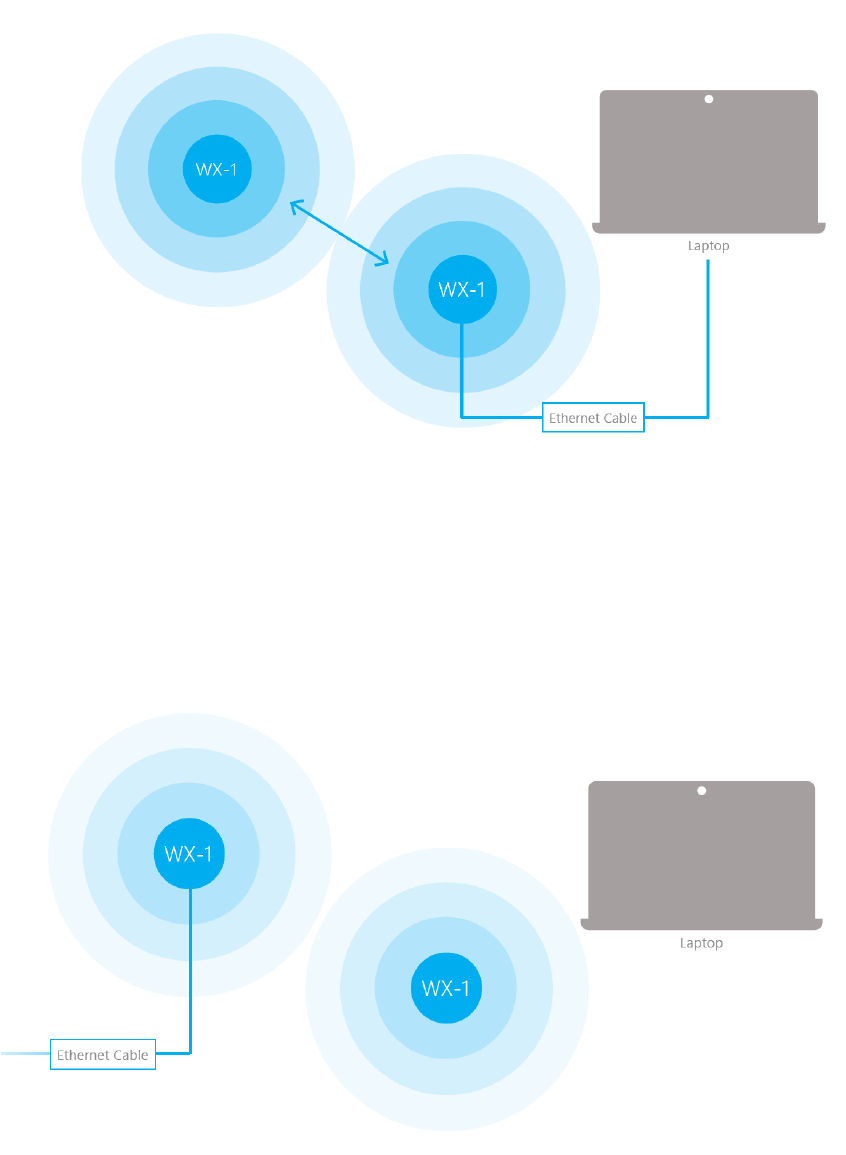
•
When you put the WX-
1
root access point mode and send it to a client device through an Ethernet connection.
• WDS Repeater –
The repeater also receives wireless signal from another access
unlike a brige access point, a repeater access point sends out Wi
connect to it wirelessly.
1
x in bridge mode, it can receive a wireless signal from an access point in
root access point mode and send it to a client device through an Ethernet connection.
The repeater also receives wireless signal from another access
unlike a brige access point, a repeater access point sends out Wi
-
Fi so that client devices can
x in bridge mode, it can receive a wireless signal from an access point in
root access point mode and send it to a client device through an Ethernet connection.
The repeater also receives wireless signal from another access
point. However,
Fi so that client devices can
The functionality of the WX-1x changes depending on its operating mode. This manual offers both
general and mode-specific content.
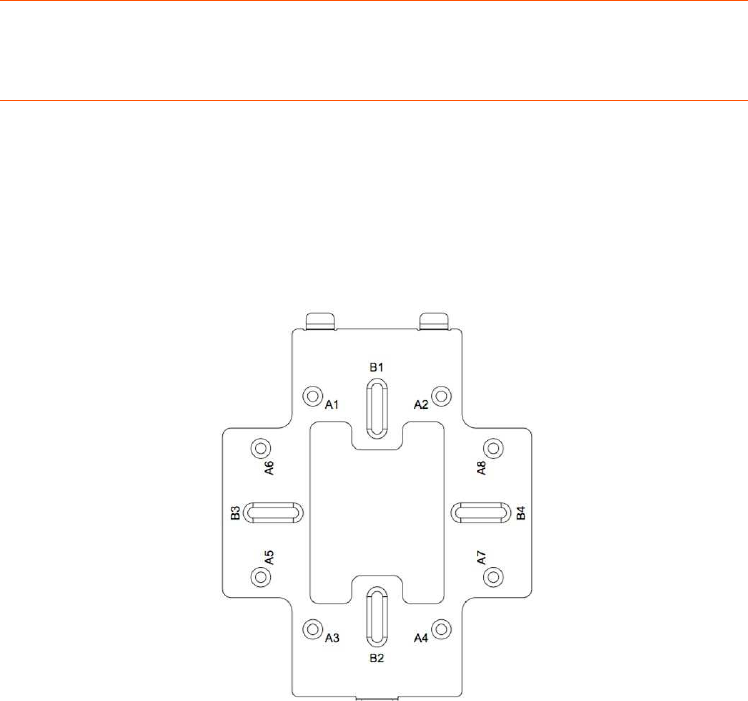
System Requirements
The minimum system requirements for the WX-1x are:
•
PC or MAC book compatible with an Ethernet interface
•
Operating system that supports an HTTP web browser
Hardware Installation
Note: the product is designed for specific application and must be professionally
installed by a qualified personal who has RF and related knowledge.
WX-1/WX-1-B Mounting Options
Using the Provided Wall Mount
A: DOUBLE-GANG ELECTRICAL BOX, WALL
B: WALL, SINGLE-GANG ELECTRICAL BOX, EUROPEAN OUTLET BOX US 4” ROUND JUNCTION BOX, US 3.5”
ROUND JUNCTION BOX
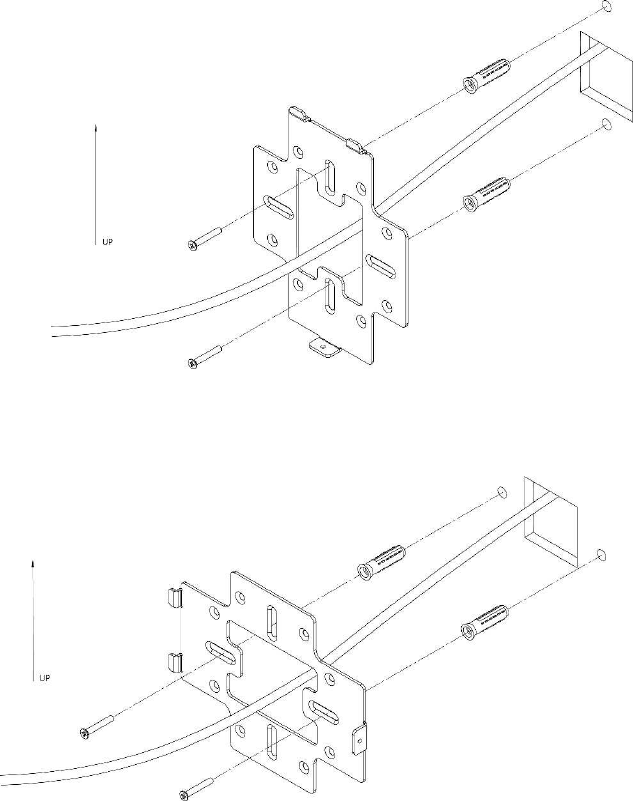
Vertical mount
: Secure the wall bracket to the wall anchors using the included hardware.
Horizontal mount
: Line up the slots and secure the wall bracket to the wall anchors using the included
hardware.
Using provide spacer to mount the Access Point (Optional)
In order to properly route the Ethernet cable to the unit use the provided spacer.
1.
Attached the wall bracket to the spacer.
2.
Route the cable through the spacer.
3.
Screw the assembled unit to the wall.
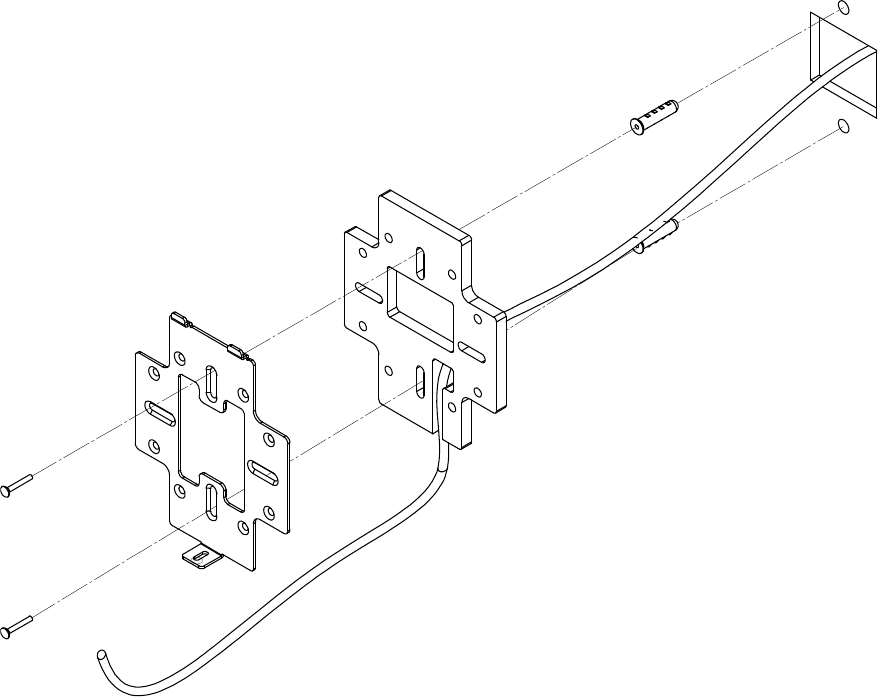
Line the two tabs on the top of the wall bracket with the two pockets on the back of the access point.
Slide the WAP downwards to lock it in place and secure with security screw.
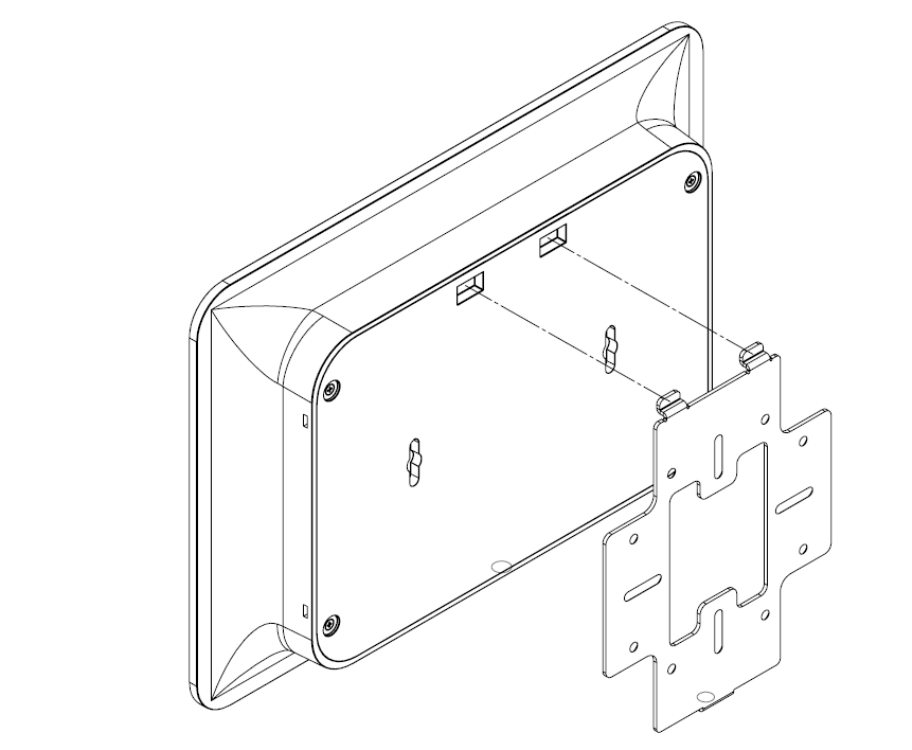
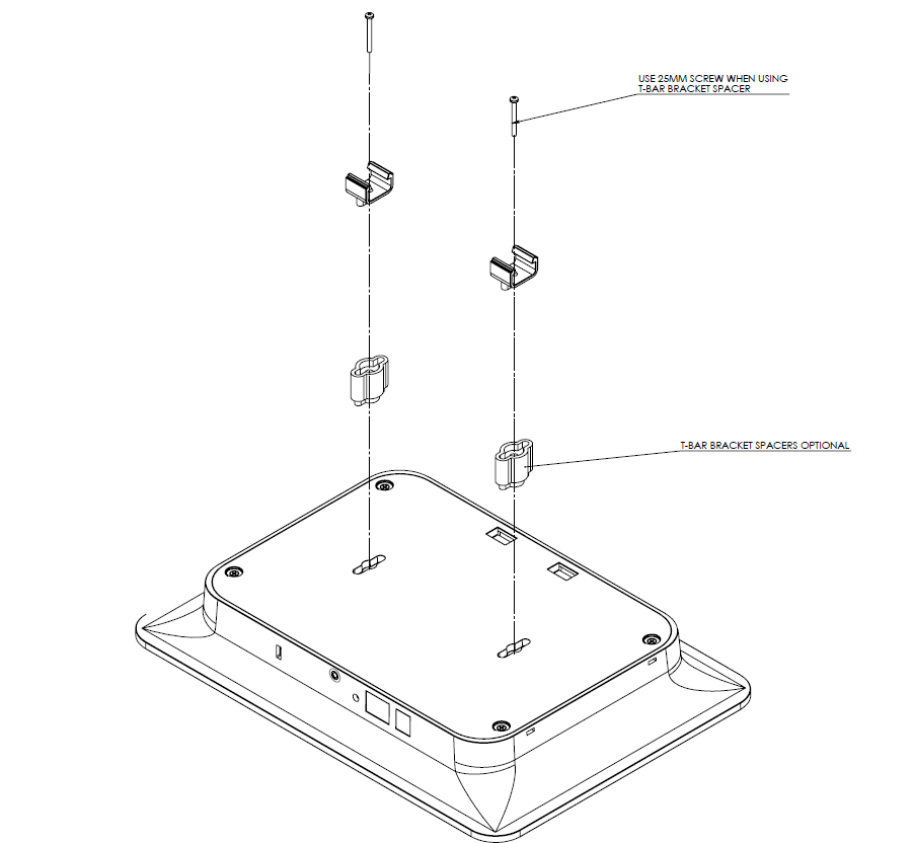
Using Provided T-bar
1.
Place the T-
bar bracket into the slots on the back of the WAP and line up the two holes on the T
Bar Bracket with the two mounting points on the back of the WAP
mount the T-bar b
racket to the WAP.
bar bracket into the slots on the back of the WAP and line up the two holes on the T
Bar Bracket with the two mounting points on the back of the WAP
.
Using the supplied hardware,
racket to the WAP.
bar bracket into the slots on the back of the WAP and line up the two holes on the T
-
Using the supplied hardware,
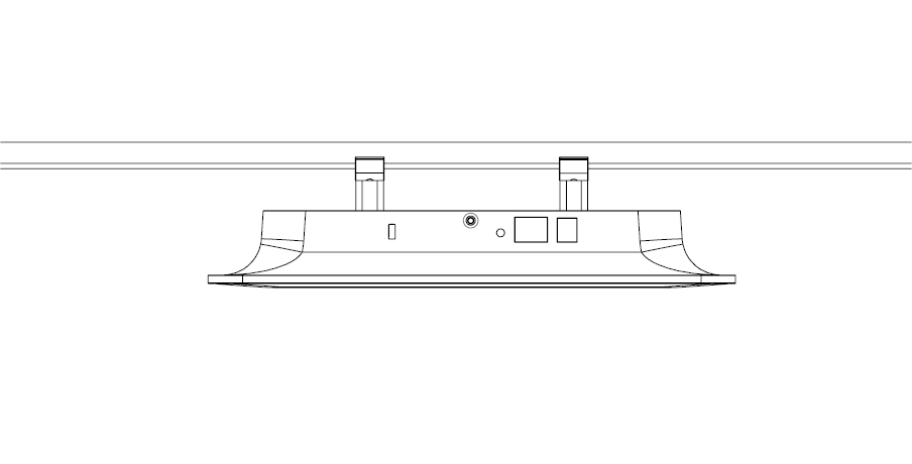
2.
Line up the T-
bar brackets with the T
bar brackets with the T
-Bar. Press down until the T-
bar brackets snap on.
bar brackets snap on.
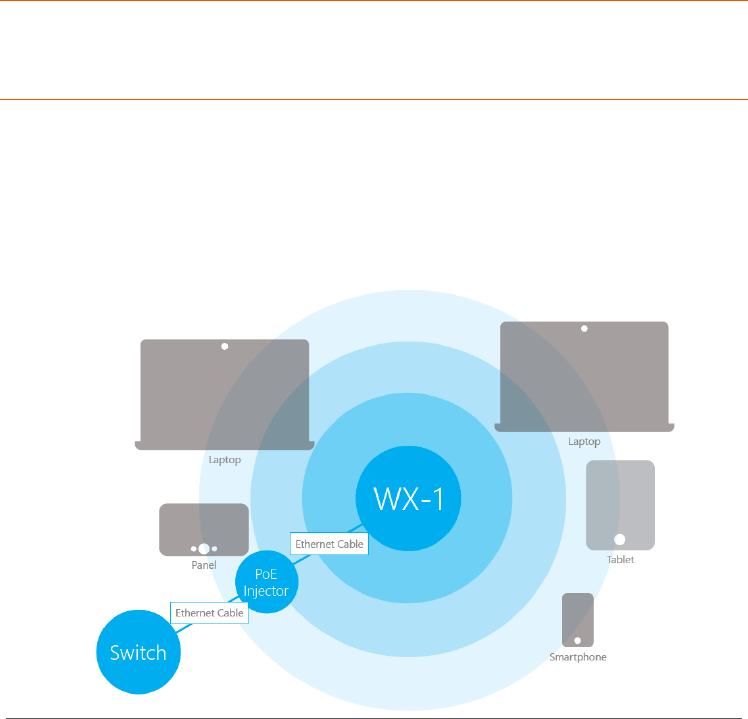
Power Method for the WX
The diagrams below show
using a PoE
Note: the product
must be powered by
Power via PoE+ Injector
Power Method for the WX
-1
using a PoE
+ injector or a PoE+ switch to power the
WX
must be powered by
802.3at -
compliant Power over Ethernet
(PoE+) injector or switch
WX
-1x.
compliant Power over Ethernet
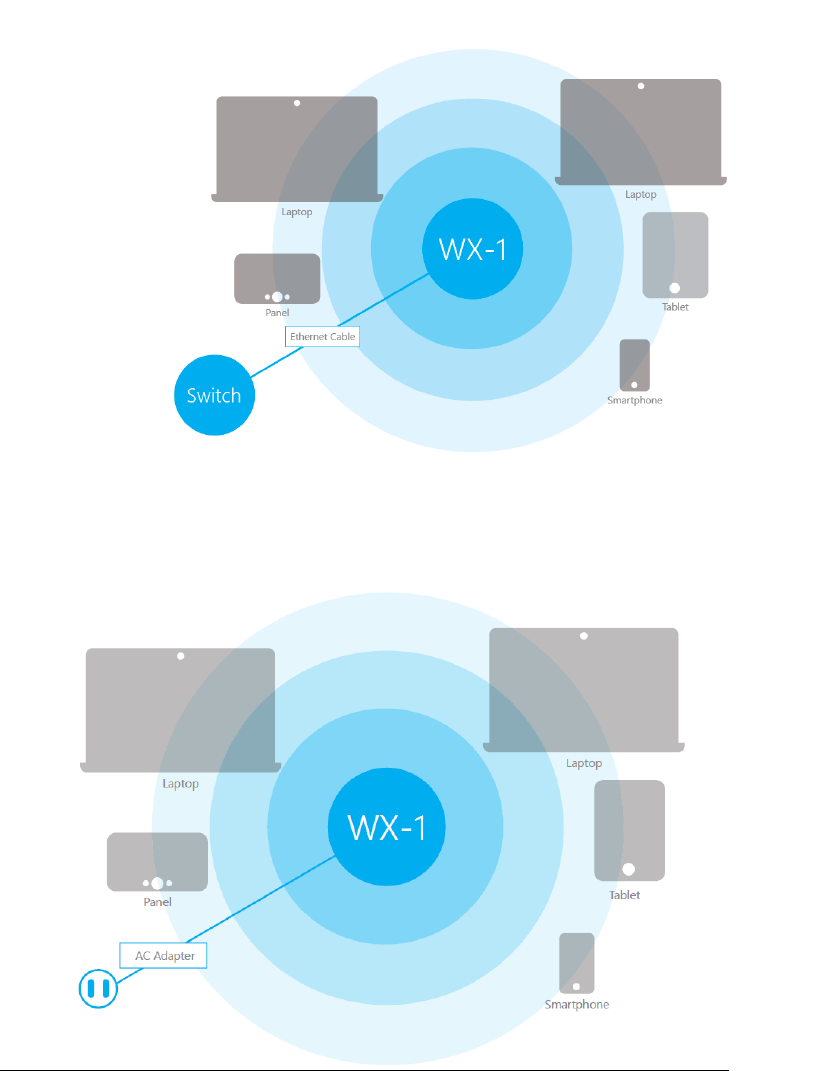
Power via PoE+ Switch
Power using the included power adapter
Power using the included power adapter

The WX-1x can be configured in several modes: Access Point, WDS Root Access Point, WDS Repeater or
WDS Bridge. When shipped from the factory, the WX-1x is set to Access Point mode. The default IP
address of the WX-1x is
192.168.1.250
and username/password of
pakedge
/
pakedgea.
In order to log into the WX-1x, you must first configure the TCP/IP settings of your PC/Notebook. Follow
these steps:
1.
Under
Control Panel
, double-click
Network Connections
and double-click the connection
of your Network Interface Card (NIC). The Local Area Connection Properties dialog appears:
2.
Select
Internet Protocol Version 4 (TCP/IPv4)
and click
Properties
. The Internet Protocol (TCP/IP)
dialog appears where you can configure the TCP/IP settings of your PC.
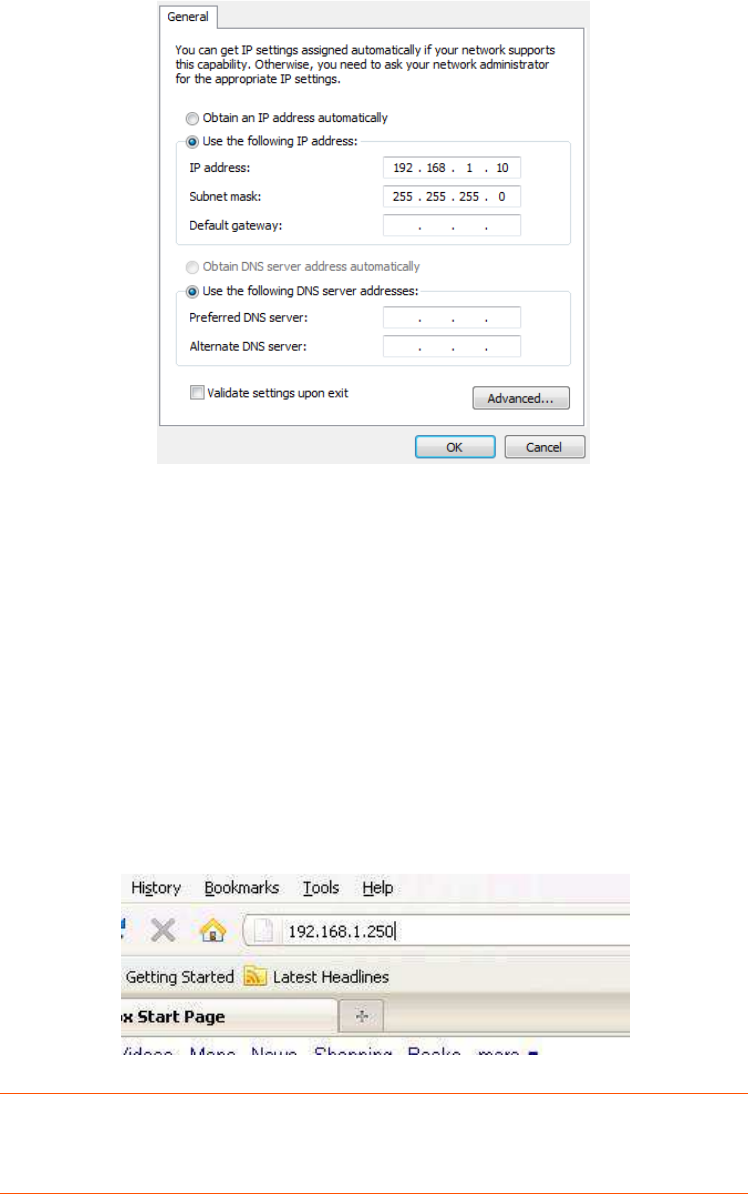
3.
Select
Use the following IP Address
and type the IP address and subnet mask, as in the example
below. (Be sure the IP address and subnet mask are on the same subnet as the WX-1x.)
WX-1x IP address: 192.168.1.250
PC IP address: 192.168.1.10
PC subnet mask: 255.255.255.0
WX-1x Start Up
To configure the WX-1x through a web browser, type the IP address of the WX-1x (default
192.168.1.250
) and press
Enter
.
NOTE:
Make sure the WX-1x and your computer are configured on the same subnet.
To configure the IP address of your computer, follow the steps in the previous section.
The WX-1x login dialog appears.
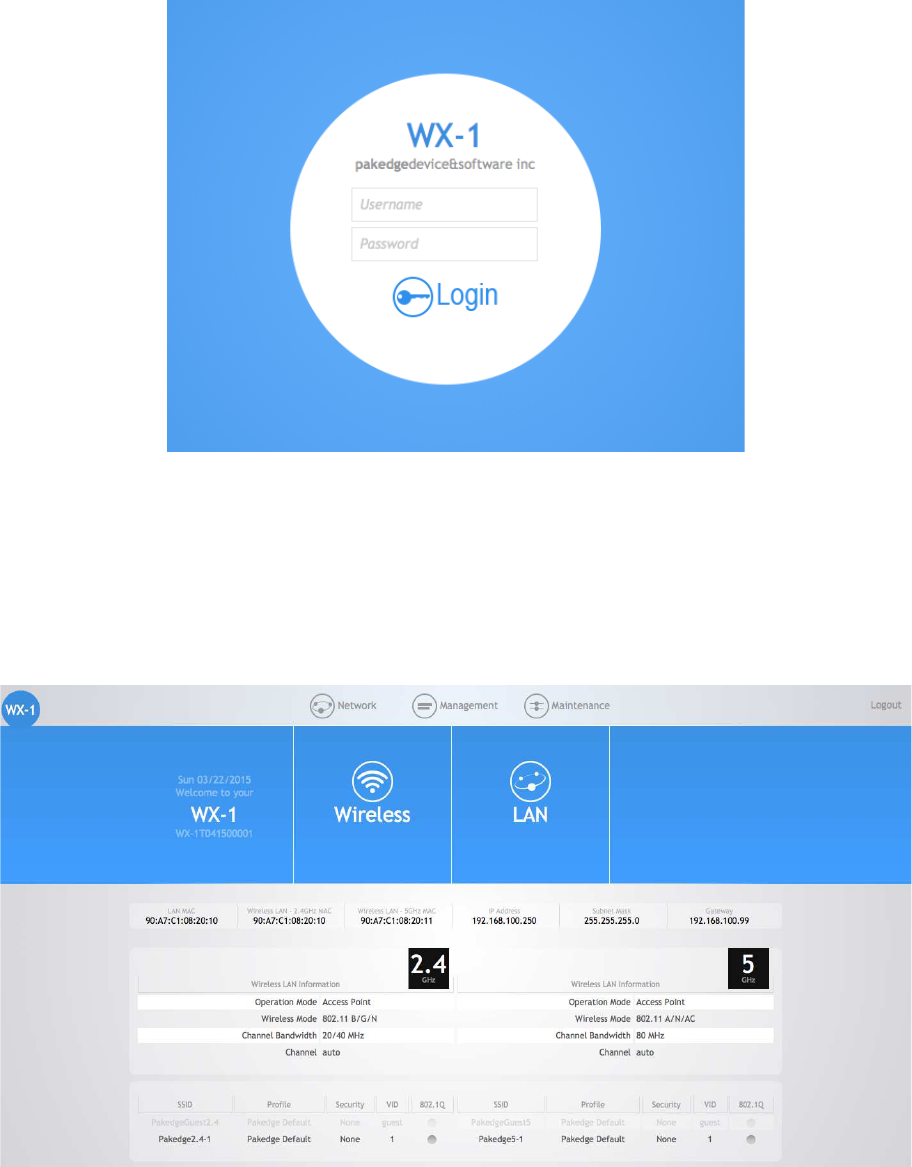
In the username box, type
pakedge
The WX-1
x main menu appears (see figure below). The main menu displays
and general information such as the IP address, subnet mask, and MAC addresses.
sections display
the device operating mode,
WX-1x supports multiple
SSIDs along with
pakedge
. In the password box, type
pakedgea
and click
x main menu appears (see figure below). The main menu displays
the current status
and general information such as the IP address, subnet mask, and MAC addresses.
the device operating mode,
wireless mode, channel bandwidth
and
SSIDs along with
details and security settings for
each SSID
and click
Login.
the current status
of WX-1x
and general information such as the IP address, subnet mask, and MAC addresses.
The 2.4 GHz and 5 GHz
and
channel settings. The
each SSID
.
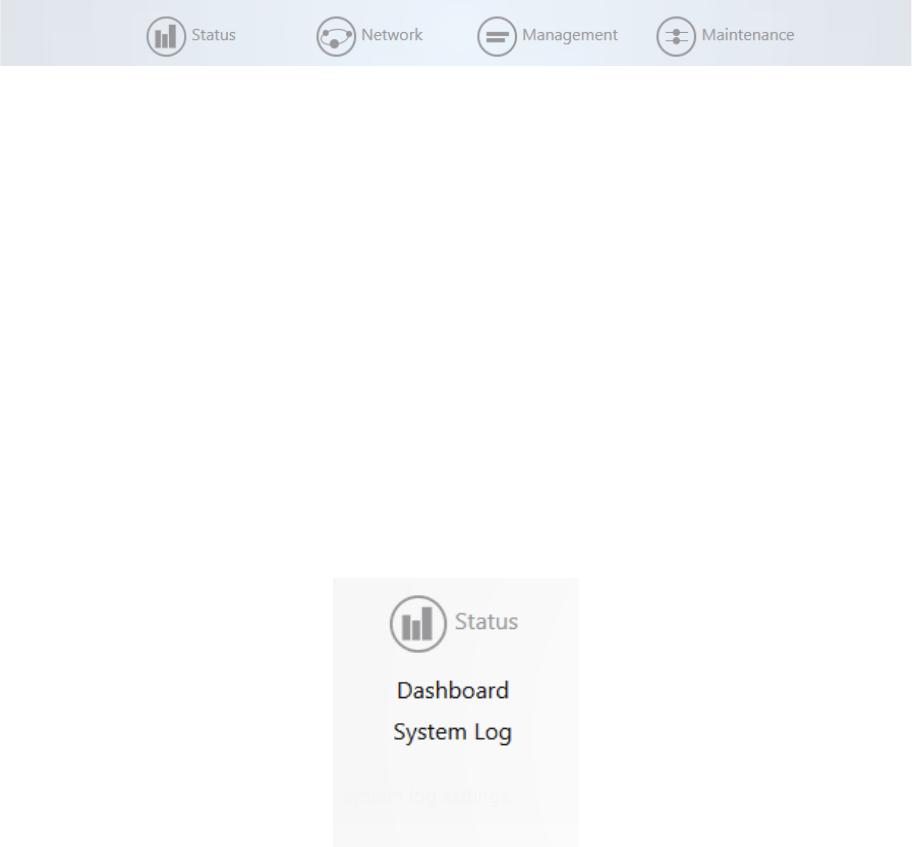
Menu Options
The navigation bar on the top
of the window comes with
•
Status: Shows
the dashboard and logs of the
page that comes up when you log into the
•
Network
: User can make changes to the network settings, such as the LAN, wireless settings, and
transmit power settings.
•
Management:
View diagnostics, enable SNMP, and control
•
Maintenance:
Modify your personal account settings and upgate your firmware.
Status
Menu Options
of the window comes with
4 options:
the dashboard and logs of the
WX-1x access point.
The dashboard is the default
page that comes up when you log into the
WX-1x GUI.
: User can make changes to the network settings, such as the LAN, wireless settings, and
View diagnostics, enable SNMP, and control
your LEDs.
Modify your personal account settings and upgate your firmware.
The dashboard is the default
: User can make changes to the network settings, such as the LAN, wireless settings, and
Modify your personal account settings and upgate your firmware.
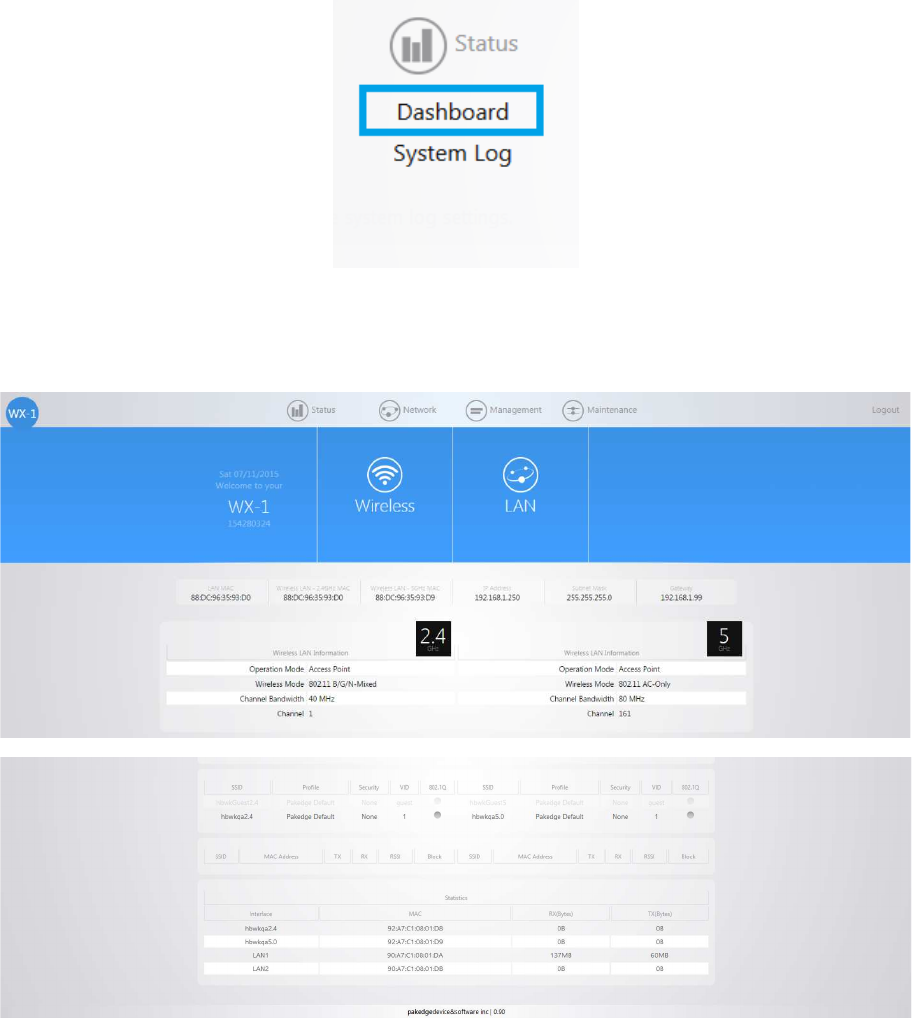
Dashboard
The Dashboard is the default landing page of the access point. You can also access this page by hovering
over the Status
icon and clicking
mode, WLAN information, SSID
s and connected clients.
The Dashboard is the default landing page of the access point. You can also access this page by hovering
icon and clicking
Dashboard
. This page displays the MAC and IP addresses
s and connected clients.
The Dashboard is the default landing page of the access point. You can also access this page by hovering
. This page displays the MAC and IP addresses
, operation
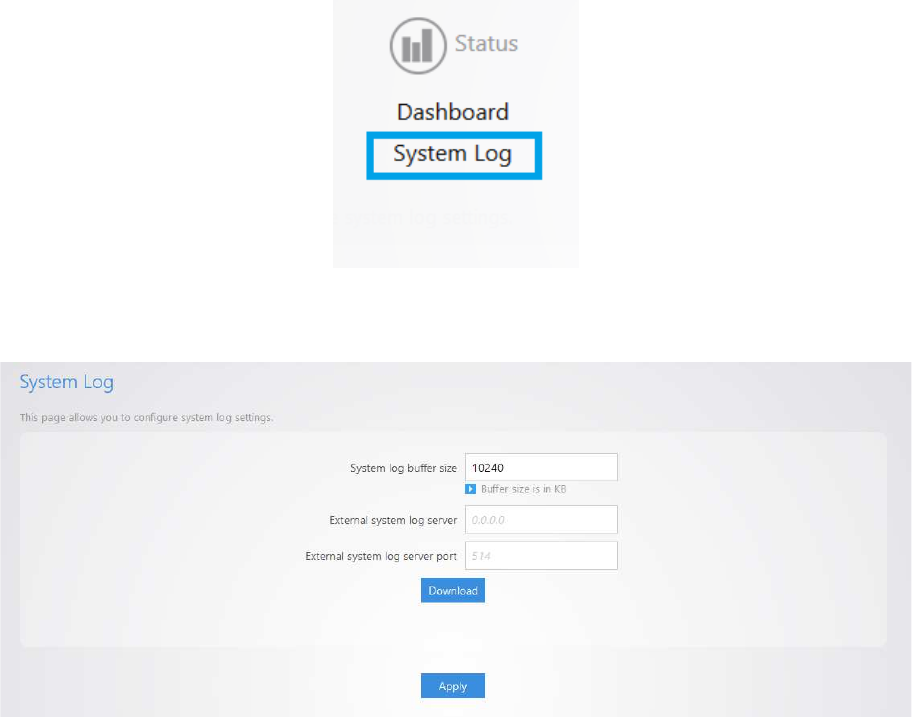
System Log
The System Log page
has an activity log that can be used by Pakedge Technical Support for
troubleshooting purposes.
•
System log buffer size
:
default setting.
•
External system log server
address of the external server.
•
External system log
port
•
Download:
Download the encrypted log.
has an activity log that can be used by Pakedge Technical Support for
:
Maximum
value of the buffer is 10240 KB (10MB)
External system log server
: An external server may be set up to receive log
address of the external server.
port
: A port number for the external server may be entered here.
Download the encrypted log.
has an activity log that can be used by Pakedge Technical Support for
value of the buffer is 10240 KB (10MB)
, which is also the
: An external server may be set up to receive log
activity. Enter the IP
: A port number for the external server may be entered here.

Network
LAN
Hover over the Network icon
and
configure the IP address of your
IP address automatically by
using a DHCP client
and
click LAN
. This page displays the LAN settings for
configure the IP address of your
WX-1x, you can configure the WX-1
x with a static IP address
using a DHCP client
.
. This page displays the LAN settings for
the WX-1x. To
x with a static IP address
or obtain an
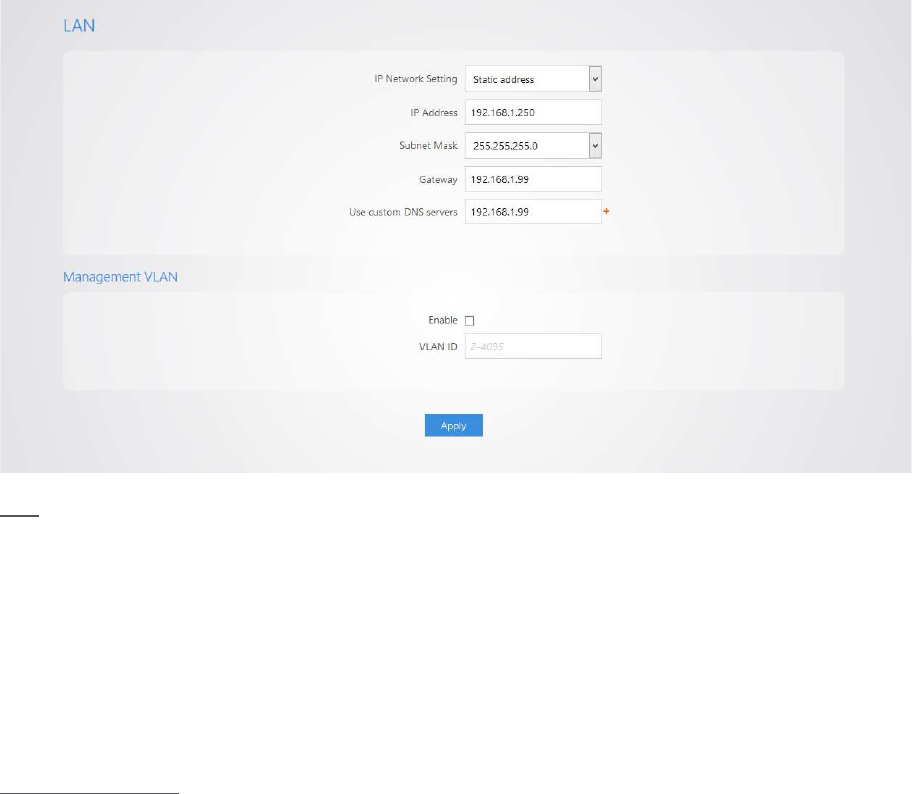
LAN
•
IP Network Setting
: If your
“
Obtain an IP address automatically
DHCP pool (
Not recommended
•
Specify an IP address (default):
appropriate entries in the text boxes for
and Secondary DNS.
•
Click “Apply”
to apply the changes.
Management VLAN
Warning: Do not enab
le this feature unless you need to
If configured incorrectly,
the access point will become inaccessible and will need to be
default. VLAN
tagging can only be set on a managed switch capable of usin
•
VLAN ID
for Management:
VLAN.
•
In the VLAN ID
text box, enter the
functions of the WX-1
x through. For example, if
•
Click Apply
to save your changes.
: If your
WX-1x
is connected to a DHCP server (such as a router), choose
Obtain an IP address automatically
”. Your WX-1x will be assign
ed an IP address from the
Not recommended
).
Specify an IP address (default):
Select this option if you want to use a static IP address. Type the
appropriate entries in the text boxes for
IP Address, IP Subnet Mask,
Default Gateway
to apply the changes.
le this feature unless you need to
tag the
default VLAN on the access point
the access point will become inaccessible and will need to be
tagging can only be set on a managed switch capable of usin
g
VLANs.
for Management:
To turn on VLAN Management, check
Enable under Management
text box, enter the
number of the
VLAN you want to access the administrative
x through. For example, if
VLAN3 is used for management, type in 3.
to save your changes.
is connected to a DHCP server (such as a router), choose
ed an IP address from the
Select this option if you want to use a static IP address. Type the
Default Gateway
, Primary
default VLAN on the access point
.
the access point will become inaccessible and will need to be
reset to factory
VLANs.
Enable under Management
VLAN you want to access the administrative
VLAN3 is used for management, type in 3.
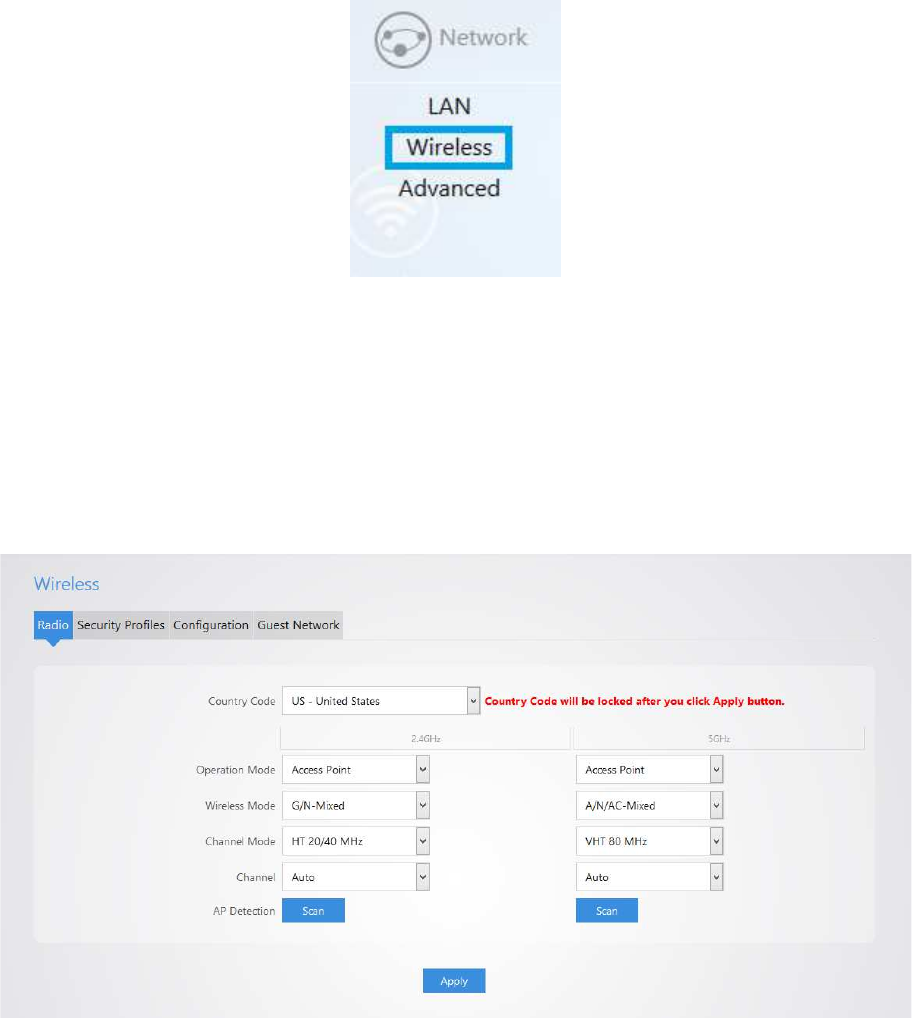
Wireless
Radio
Hover over Network
and click on
the Radio tab.
•
Country Code
: Selecting your country is
required by law.
After selecting your country and clicking Apply, the Country Code feature will
become locked. T
o regain access to Country Code,
and click on
Wireless
, you will be directed to the Radio configuration page under
: Selecting your country is
required for proper functionality of this device and may be
After selecting your country and clicking Apply, the Country Code feature will
o regain access to Country Code,
the access point must be
reset to factory default.
, you will be directed to the Radio configuration page under
required for proper functionality of this device and may be
After selecting your country and clicking Apply, the Country Code feature will
reset to factory default.

•
Band Steering: Band steering steers 5Ghz capable clients to that frequency. By enabling this function,
the 2.4GHz SSID and settings will be copied to the 5GHz band.
•
Operation Mode: Both the 2.4 and the 5 GHz band have the following operating modes: Access Point,
WDS Root Access Point, WDS Repeater and WDS Bridge.
o
Access Point: Standard mode of operation. Allows a wireless connection to the LAN.
o
WDS Root Access Point: The access point with this mode set will be the “root” device that
access points configured with WDS Repeater and WDS Bridge will connect to.
o
WDS Repeater: This mode allows the access point to connect to a WDS Root Access Point.
This setting will take the SSID broadcasted by the WDS Root Access Point and rebroadcast it
to end user devices.
o
WDS Bridge: This mode allows the access point to connect to a WDS Root Access Point. This
mode takes in the SSID broadcasted by the WDS Root Access Point and turns it into Ethernet
connectivity for client devicess.
•
Wireless Mode: Choose the setting that corresponds to the type of wireless clients connected to your
network: B-Only, G-Only, B/G-Mixed, N/G-Mixed or B/G/N-Mixed (on the 2.4GHz) or A-Only, N-Only,
N/A-Mixed, AC-Only, AC/N-Mixed or A/AC/N-Mixed (on the 5GHz). If you aren’t sure which type(s) of
clients will access the wireless networks, it’s recommended to choose B/G/N-Mixed on the 2.4GHz
and A/AC/N-Mixed on the 5GHz for best performance.
NOTE: When set to a mixed mode, ALL devices connected to the wireless will use the
mode that is compatible for ALL devices. Example – If you have the 2.4GHz Wireless
set to B/G/N Mixed and all connected devices use G, the speeds will slow accordingly.
•
Channel Mode: By default, the Channel Mode is set to HT 20/40 MHz (when using 2.4GHz) and HT
80 MHz (when using 5GHz). Selecting the HT 40 MHz channel mode on 2.4 GHz will allow for greater
speeds, but at the risk of also increasing interference.
o
Example: When using the 20 MHz channel width on the 2.4GHz band, channel 6 would bleed
into channels 4, 5, 7 and 8 giving you three non-overlapping channels (1, 6 and 11). When
using 40MHz channel width on the 2.4GHz radio, channel 6 would bleed into channels 2, 3, 4,
5, 7, 8, 9, and 10.
•
Channel – Using the default setting (Auto), the WX-1x automatically selects the channel with best
performance for the wireless network. To select a channel manually, click the drop-down list and
select a channel. The channel options available depend on the Country Code selected.
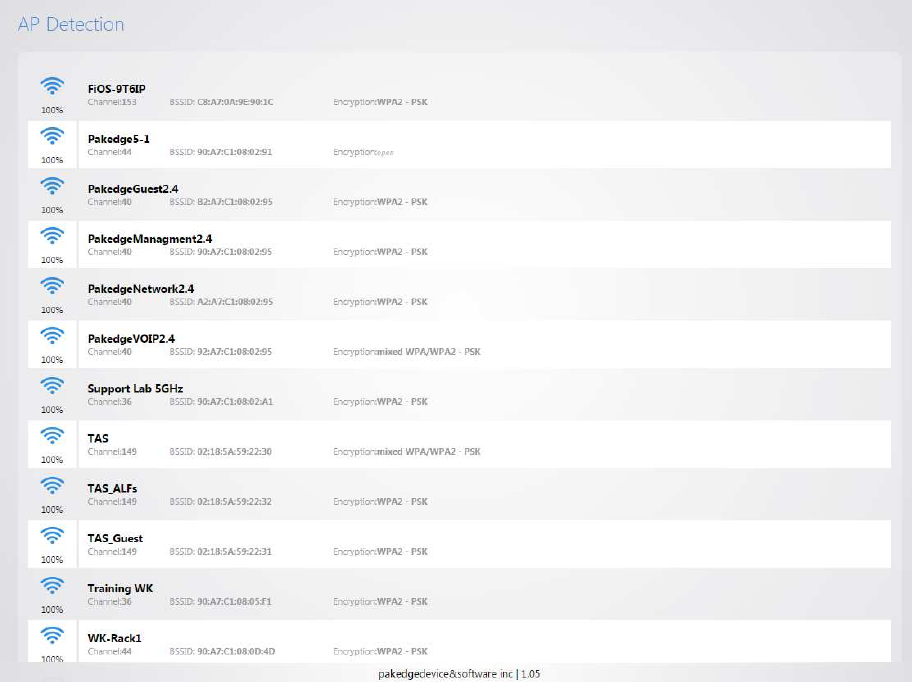
•
AP Detection – Click “Scan” to perform an automatic site survey. A new window will open and
display the site survey utility. The WX-1x will scan the frequency for devices currently broadcasting
their SSID, and then will display them in the table.

Security Profiles
Under the Security Profiles
tab, you will be able to configure security profiles that can be used when
creating SSIDs under the configuration tab.
•
Profile Name:
Create a name for the security profile.
•
Encryption: Se
lect an encryption type for your security profile
Encryption, WPA PSK, WPA2 PSK, and WPA/WPA2 PSK.
o
No Encryption
: This will leave your profile without security
o
WPA PSK
: Password must be at least 8
protocol
(not recommended).
o
WPA2 PSK
: Password must be at least 8 characters long. AES
(Recommended)
o
WPA/WPA2 PSK
as Mixe
d Mode and uses TKIP encryption.
NOTE: Passwords may only contain numbers and letters
allowed. Example
Security Profiles
tab, you will be able to configure security profiles that can be used when
creating SSIDs under the configuration tab.
Create a name for the security profile.
lect an encryption type for your security profile
.
The four available options are, No
Encryption, WPA PSK, WPA2 PSK, and WPA/WPA2 PSK.
: This will leave your profile without security
(not r
ecommended)
: Password must be at least 8
characters long.
This is a legacy encryption
(not recommended).
: Password must be at least 8 characters long. AES
-
only encryption.
(Recommended)
WPA/WPA2 PSK
: Password must be at least 8 characters long. This feature is also known
d Mode and uses TKIP encryption.
NOTE: Passwords may only contain numbers and letters
.
Special characters are not
allowed. Example
s of special characters: (!@#$%:;^&*).
tab, you will be able to configure security profiles that can be used when
The four available options are, No
ecommended)
.
This is a legacy encryption
only encryption.
: Password must be at least 8 characters long. This feature is also known
Special characters are not

Configuration
To configure SSIDs for both the 2.4 GHz and 5 GHz bands, go to
set up to 8 SSIDs
per band for a total of 16 SSID
•
On Off
: The SSID may be turned on or turned off using this checkbox.
•
Wireless Name (SSID)
: The SSID is the name associated with the W
exceed 32 characters.
•
Security Profile
: The profiles created under the Security Profiles tab may be applied to the SSID
here.
•
Hide SSID: Enabling
this feature will keep the SSID
be ava
ilable for client access
•
Client Isolation
: This feature is also referred to as “station separation”
clients on the same
SSID
Configuration
To configure SSIDs for both the 2.4 GHz and 5 GHz bands, go to
the Config
uration
per band for a total of 16 SSID
s.
: The SSID may be turned on or turned off using this checkbox.
: The SSID is the name associated with the W
i-Fi
network. An SSID cannot
: The profiles created under the Security Profiles tab may be applied to the SSID
this feature will keep the SSID
name from being broadcast
ilable for client access
, provided the SSID is turned on.
This is not a security feature.
: This feature is also referred to as “station separation”
.
This feature prevents
SSID
from being able to access other clients on
the network.
uration
tab. The WX-1x can
network. An SSID cannot
: The profiles created under the Security Profiles tab may be applied to the SSID
name from being broadcast
. The SSID will still
This is not a security feature.
This feature prevents
the network.

•
Pakedge Zone (VLAN)
: This option defines the
change the VLAN
, select the grey cir
with the available VLAN options.
•
Manage: This column d
isplay
Management VLAN. Management VLAN is located on the LAN page under Network.
Guest Network
The Guest Network feature is designed for networks that do not have a guest VLAN. The Guest
acts as its own network and
only has access to the internet. Each access point’s guest network is
independent from
the guest networks of other access points.
To enable the Guest Network,
select On/Off. By default
the IP scheme is
set to 192.168.200.X. You have the optio
can change the SSID, IP address, subnet,
complete, click Apply to save
them.
: This option defines the
VLAN that
on which the SSID will reside.
, select the grey cir
cle with the number 1 inside it. A
selection ring will appear
with the available VLAN options.
isplay
s the management settings
that were configured under
Management VLAN. Management VLAN is located on the LAN page under Network.
Guest Network
Settings
The Guest Network feature is designed for networks that do not have a guest VLAN. The Guest
only has access to the internet. Each access point’s guest network is
the guest networks of other access points.
select On/Off. By default
,
the guest network name is Pakedge
set to 192.168.200.X. You have the optio
n to change the default settings, if desired. You
can change the SSID, IP address, subnet,
starting IP address and ending IP address. Once changes are
them.
on which the SSID will reside.
To
selection ring will appear
that were configured under
Management VLAN. Management VLAN is located on the LAN page under Network.
The Guest Network feature is designed for networks that do not have a guest VLAN. The Guest
Network
only has access to the internet. Each access point’s guest network is
the guest network name is Pakedge
-Guest and
n to change the default settings, if desired. You
starting IP address and ending IP address. Once changes are
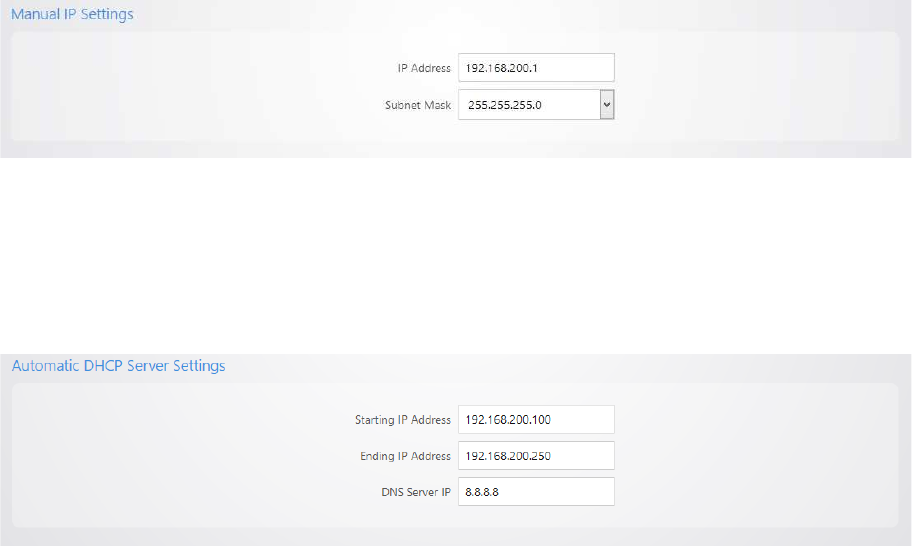
SSID
•
Radio
: There is a guest network available on both the 2.4 GHz and 5 GHz band.
•
On/Off
: This option turns the Guest Network on and off.
•
Wireless Name (SSID)
: The SSID of the Guest Network can be entered in this textbox.
•
Security Profile
: Select a
tab.
Manual IP Settings
•
IP Address
: Enter in the
•
Subnet Mask
: Select the class of the guest network
selected by default.
Manual IP Settings
•
Starting IP Address
: This is the beginning of the DHCP range used on the guest network.
have multiple access points, you can give them the same DHCP range because the guest network
of each access
point will be independent of one another.
•
Ending IP Address
: This is the last IP address available o
•
DNS Server IP
: The DNS Server IP can be set to an external DNS or to the router’s IP address if
the router provides a DNS server.
: There is a guest network available on both the 2.4 GHz and 5 GHz band.
: This option turns the Guest Network on and off.
: The SSID of the Guest Network can be entered in this textbox.
: Select a
security profile that has already been defined under the Security Profiles
: Enter in the
IP address the access point will be used on.
: Select the class of the guest network
.
255.255.255.0 is the standard set
: This is the beginning of the DHCP range used on the guest network.
have multiple access points, you can give them the same DHCP range because the guest network
point will be independent of one another.
: This is the last IP address available o
n
the DHCP range
: The DNS Server IP can be set to an external DNS or to the router’s IP address if
the router provides a DNS server.
: There is a guest network available on both the 2.4 GHz and 5 GHz band.
: The SSID of the Guest Network can be entered in this textbox.
security profile that has already been defined under the Security Profiles
255.255.255.0 is the standard set
ting and is
: This is the beginning of the DHCP range used on the guest network.
If you
have multiple access points, you can give them the same DHCP range because the guest network
the DHCP range
.
: The DNS Server IP can be set to an external DNS or to the router’s IP address if
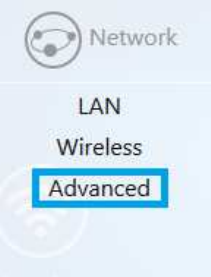
Advanced
On the Advanced
page, you can configure:
Transmit Power: The power depends on the distance of the devices in your wireless network. From the
drop-
down list, select the desired power. You can use this feature to limit the coverage area of the
wireless network.
o
Maximum: This setting will broadcast at the maximum allowed mW for the channel
selected if Obey Regulatory Power is checked. If Obey Regulatory Power is not checked,
then the maximum 30 dBm (1000 mW) will be broadcast.
o
Automatic: This
setting will adjust the power of the access point based on the distance to
the furthest client device. The access point will lower its power if the furthest client is 10
feet away and will raise the power if the furthest client is 100 feet away.
o
1 dBm (1 mW) –
broadcast at the selected power level.
Obey Regulatory Power:
This feature will enable government mandated power levels per channel based
on the access point’s Country Code.
•
RTS/CTS Threshold
: Enter the packet size threshold for RTS/CTS (Request to Send/Clear to
to occur. The primary reason for implementing this function is to minimize the collision between
hidden stations, which occurs when access points and wireless users
and there is a high occurrence of retransmissions on the wireless LAN. Default setting is 2347.
•
Beacon Interval
: Adjusting Beacon Interval will allow clients to sleep longer. Clients have to wake
up for every beacon, so this se
BP = 100 your stations are allowed to sleep for up to 100
page, you can configure:
Transmit Power: The power depends on the distance of the devices in your wireless network. From the
down list, select the desired power. You can use this feature to limit the coverage area of the
Maximum: This setting will broadcast at the maximum allowed mW for the channel
selected if Obey Regulatory Power is checked. If Obey Regulatory Power is not checked,
then the maximum 30 dBm (1000 mW) will be broadcast.
setting will adjust the power of the access point based on the distance to
the furthest client device. The access point will lower its power if the furthest client is 10
feet away and will raise the power if the furthest client is 100 feet away.
30 dBm (1000 mW):
These are static power settings. The access point will
broadcast at the selected power level.
This feature will enable government mandated power levels per channel based
on the access point’s Country Code.
: Enter the packet size threshold for RTS/CTS (Request to Send/Clear to
to occur. The primary reason for implementing this function is to minimize the collision between
hidden stations, which occurs when access points and wireless users
are spread out in a location
and there is a high occurrence of retransmissions on the wireless LAN. Default setting is 2347.
: Adjusting Beacon Interval will allow clients to sleep longer. Clients have to wake
up for every beacon, so this se
tting tells your client how many milliseconds it can sleep for (e.g., if
BP = 100 your stations are allowed to sleep for up to 100
ms).
Transmit Power: The power depends on the distance of the devices in your wireless network. From the
down list, select the desired power. You can use this feature to limit the coverage area of the
Maximum: This setting will broadcast at the maximum allowed mW for the channel
selected if Obey Regulatory Power is checked. If Obey Regulatory Power is not checked,
setting will adjust the power of the access point based on the distance to
the furthest client device. The access point will lower its power if the furthest client is 10
feet away and will raise the power if the furthest client is 100 feet away.
These are static power settings. The access point will
This feature will enable government mandated power levels per channel based
: Enter the packet size threshold for RTS/CTS (Request to Send/Clear to
Send)
to occur. The primary reason for implementing this function is to minimize the collision between
are spread out in a location
and there is a high occurrence of retransmissions on the wireless LAN. Default setting is 2347.
: Adjusting Beacon Interval will allow clients to sleep longer. Clients have to wake
tting tells your client how many milliseconds it can sleep for (e.g., if
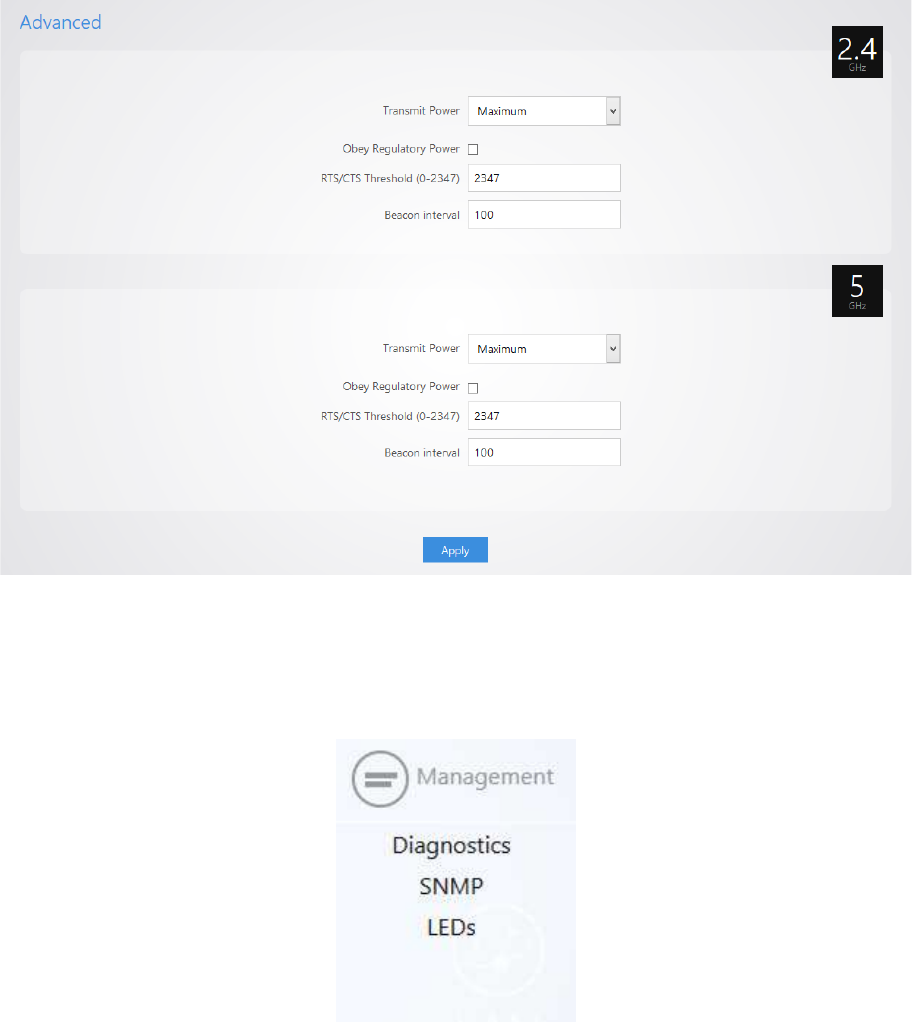
Management
Management
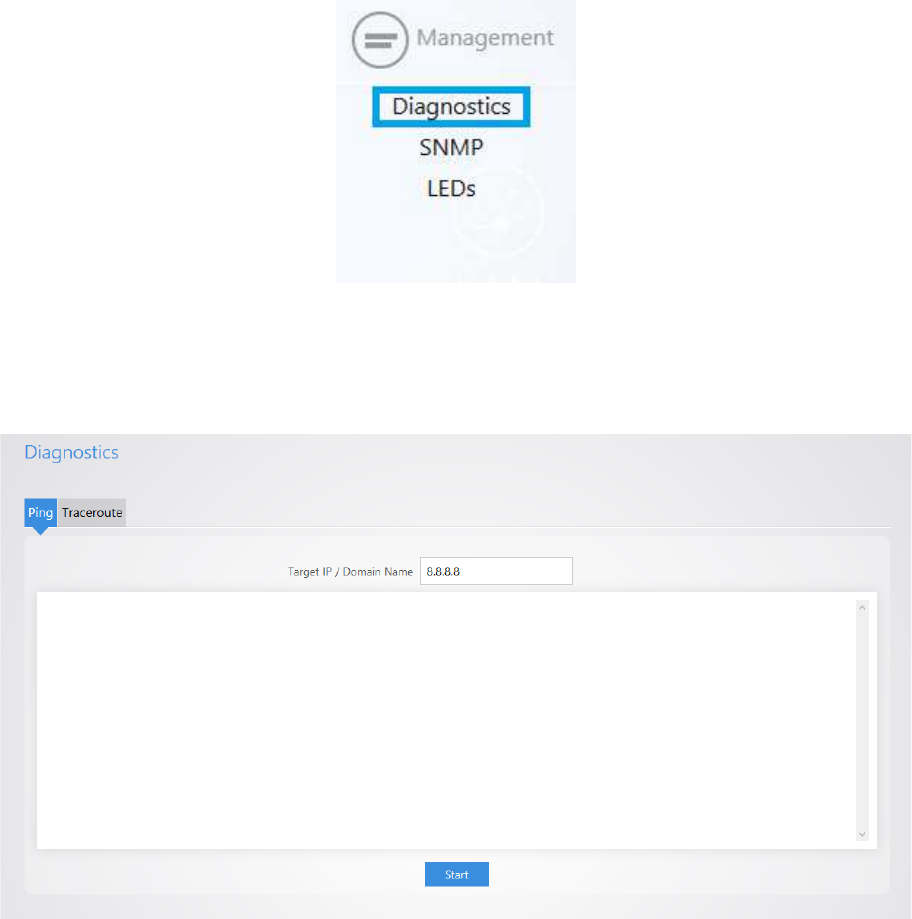
Diagnostics
Ping
Hover over Management
and click on
tab:
•
Ping –
o
Target IP / Domain Name
DNS server.
o
Click Start
to start the test.
and click on
Diagnostics. You will be directed to the
ping test under the
Target IP / Domain Name
: Enter the IP Address of a location to ping. 8.8.8.8 is a Google
to start the test.
ping test under the
Ping
: Enter the IP Address of a location to ping. 8.8.8.8 is a Google
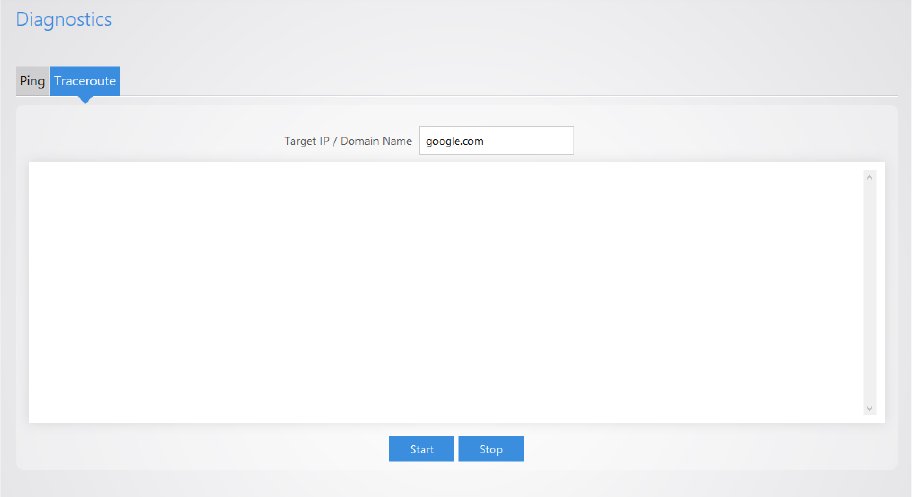
Traceroute
Click on the Traceroute tab.
A Traceroute test can help you identify obstacles you may have in the network. The Traceroute text maps
the path for packets moving
between the
an IP Address or Domain Name into the
test. If the test fails to complete or
A Traceroute test can help you identify obstacles you may have in the network. The Traceroute text maps
between the
WX-1
x and the target location. To run a Traceroute test, enter
an IP Address or Domain Name into the
Target IP / Domain Name
textbox and click
test. If the test fails to complete or
takes too long, click Stop.
A Traceroute test can help you identify obstacles you may have in the network. The Traceroute text maps
x and the target location. To run a Traceroute test, enter
textbox and click
Start to begin the
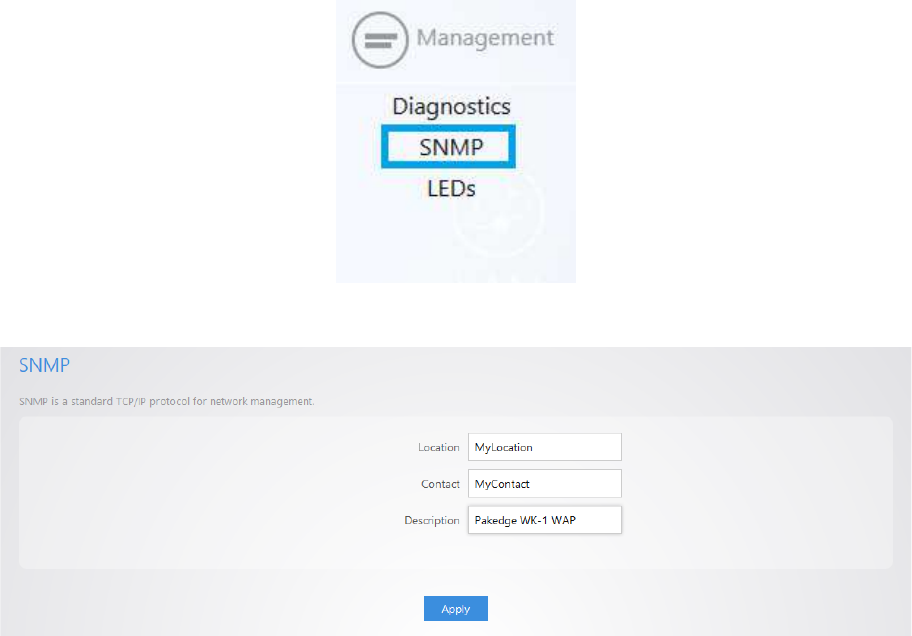
SNMP
Hover over Management
and click on SNMP.
•
Location
: Enter the physical location of the
•
Contact: Enter the
contact information of the installer or network administrator for the SNMP
manager.
•
Description
: Enter in a description of the device.
and click on SNMP.
: Enter the physical location of the
WX-1x as a reference.
contact information of the installer or network administrator for the SNMP
: Enter in a description of the device.
The d
efault description is Pakedge
contact information of the installer or network administrator for the SNMP
efault description is Pakedge
WX-1 WAP.

LEDs
Hover over Management
and click on LEDs.
•
Turn off all LEDs
: Check
Maintenance
and click on LEDs.
: Check
to turn LEDs off.
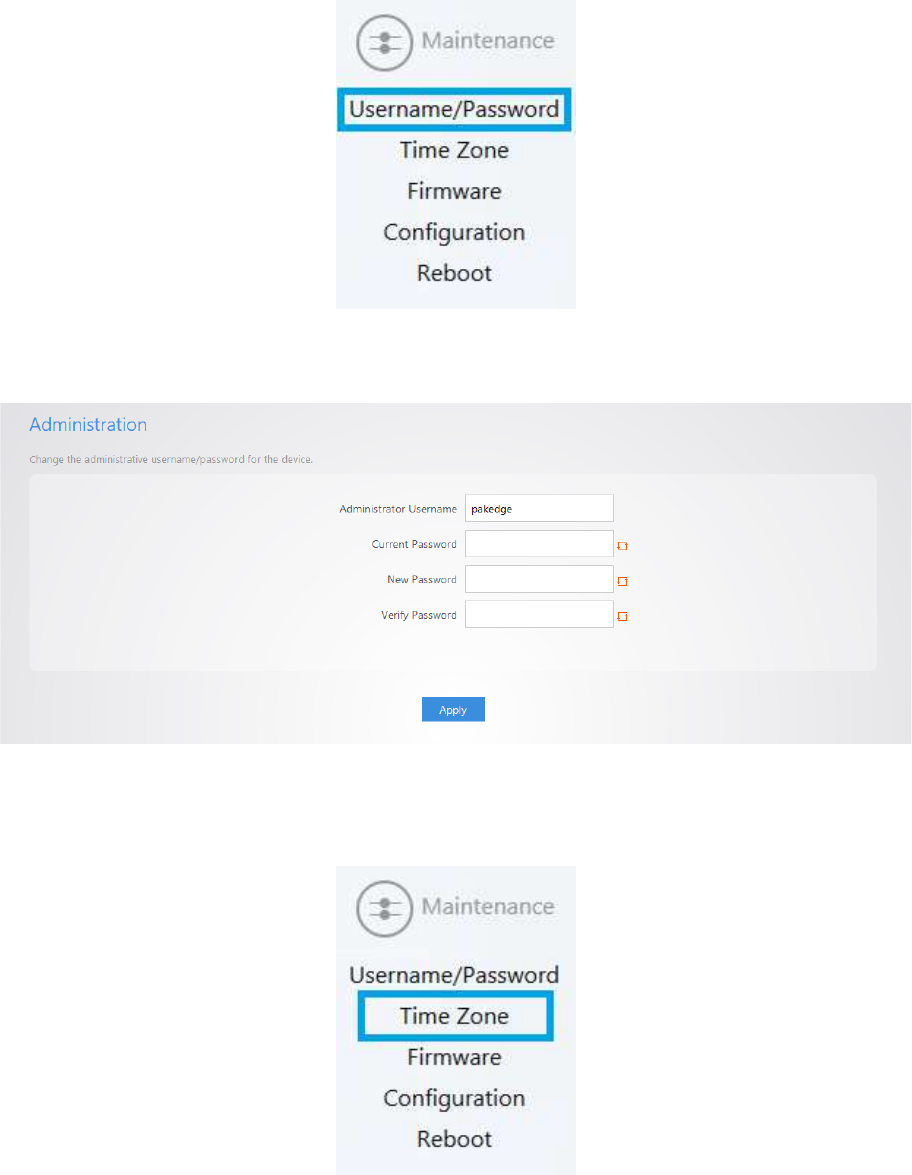
Username/Password
Hover over Maintenance
and click on
password for the device here.
Time Zone
Hover over Maintenance
and click on
and click on
Username/Password
. You can change the username and
and click on
Time Zone. This page allows you to set
up
. You can change the username and
up
the timezone.
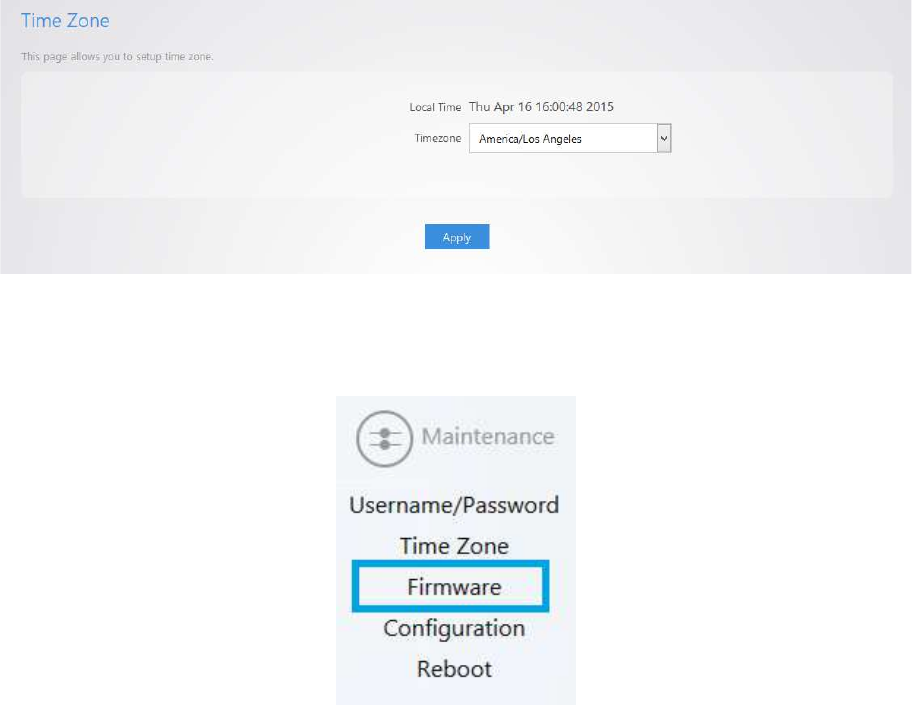
Firmware
Allows
you to update the firmware for the unit.
•
Keep Settings:
Selecting
•
Local Image:
Click Choose File to select the firmware file.
•
Local Update: Update
s the firmware with the file you selected.
•
Check Update
: This feature will
you to update the firmware for the unit.
Selecting
this will preserve your current configuration
s after the firmware update.
Click Choose File to select the firmware file.
s the firmware with the file you selected.
: This feature will
only work if the WX-1x is
connected to the internet.
s after the firmware update.
connected to the internet.
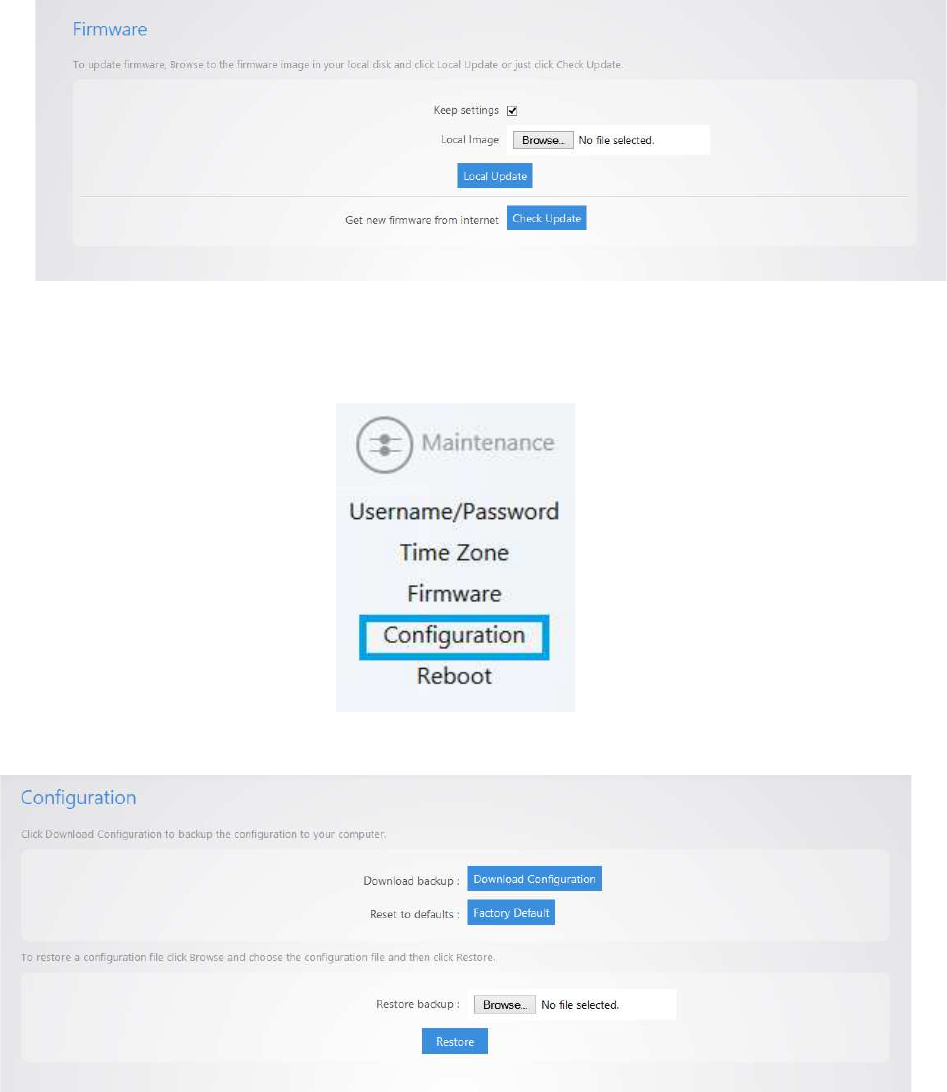
Configuration
Hover over Maintenance
and click on
•
Download backup
: Click
WX-1x.
•
Reset to defaults: Click
and click on
Configuration:
: Click
Download Configuration
to save and export the current settings of the
Factory Default to reset the the WX-1x back to
its
to save and export the current settings of the
its
factory default settings.
•
Restore backup – Load a configuration file using the Browse button to restore the WX-1x to a
previous configuration.
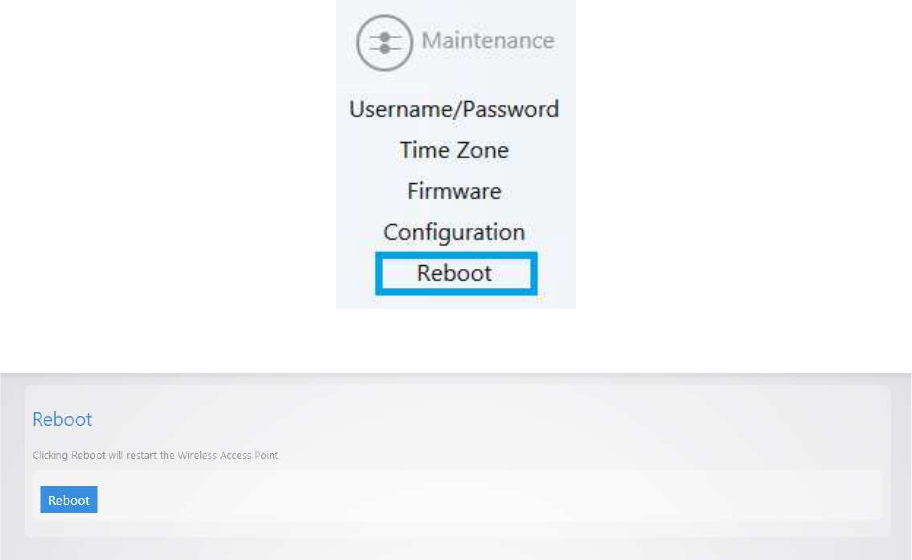
Reboot
Hover over Maintenance
and click on Reboot
C
licking the Reboot Button allows you to reboot the device.
and click on Reboot
.
licking the Reboot Button allows you to reboot the device.
Appendix A – Specs
HARDWARE SPECIFICATIONS
•
1 x 10/100/1000 Gigabit Ethernet RJ-45 port with IEEE 802.3at Power over Ethernet (PoE+)
support
•
Configurable LED Indicators for Power, Ethernet, 2.4GHz Wireless and 5GHz Wireless
•
Power over Ethernet (PoE+) IEEE802.3at compliant
•
Power Supply: 100 to 240 VDC ± 10%, 50/60 Hz (depends on different countries)
•
DC input: 12V/2A
RF INFORMATION
•
Frequency Band:
o
802.11 B/G/N on 2.4 to 2.462GHz, which can be programed based on country regulations.
o
802.11 A/N/AC on 5 to 5.805GHz, which can be programed based on country regulations.
•
Operating Channels:
o
2.4 GHz - 11 for North America, 13 for Europe, 14 for Japan
o
5 GHz – 24 channels depending on country
OPERATIONS
•
Operation Modes:
o
2.4/5 GHz have independent operation modes
o
Access Point/ WDS Bridge/WDS AP/Repeater
•
Up to 16 SSIDs
•
Supports 802.1q VLANs
•
Spanning Tree Supports 802.1d Spanning Tree Protocol
•
IP Auto-configuration – DHCP client
•
Transmission rate options:
O
2.4 GHZ – B-ONLY, G-ONLY, B/G-MIXED, N-ONLY, G/N-MIXED, B/G/N-MIXED
O
5 GHZ – A-ONLY, N-ONLY, A/N MIXED, AC-ONLY, N/AC-MIXED, A/N/AC-MIXED
MANAGEMENT AND SECURITY
•
User can adjust power by dBm
•
Web-based configuration (HTTP)
•
Upgrade firmware via web browser/internet
•
Auto-channel selects the least congested channel
•
Backup and restoration settings available through web interface
•
QoS WMM
•
WPA-PSK/WPA2-PSK/ WPA/WPA2 Mixed using TKIP or AES
•
SSID broadcast can be enabled or disabled
•
WLAN L2 Isolation (AP mode only)
•
List of connected wireless clients available
ENVIRONMENT
•
Temperature Range
o
Operating: 0ºC to 45ºC (32º to 113ºF)
o
Storage: -20ºC to 60ºC (-4Fº to 140ºF)
•
Humidity (non-condensing)
o
Operating: 90% or less
o
Storage: 90% or less
MECHANICAL
Enclosure: 9.81 inches X 7.05 inches
o
Depth: 1.51 inches
o
Base 7.76 inches X 5.55 inches
Appendix B – Accessory List
WX-1, WX-1-B
•
Quick Start Guide
•
AC100-240V, 50-60Hz DC12V 2A power adapter
•
CAT5e cable
•
Mounting bracket
•
T-bar mount
•
Screws
Appendix C – Technical Support
Please visit our website for up-to-date support information:
Website: www.pakedge.com
Email: support@pakedge.com
CONTACT INFORMATION:
Northern California Office
Pakedge Device & Software
3847 Breakwater Avenue
Hayward, CA 94545-3606
Southern California Office:
Pakedge Device & Software
17011 Beach Blvd. Suite 600
Huntington Beach, CA 92647-5946
Appendix D – Limited Warranty
Model WX-1x
Congratulations on your purchase of a Pakedge Device & Software wireless product! Pakedge designs
and manufactures the finest home networking products. With proper installation, setup, and care, you
should enjoy many years of unparalleled performance. Please read this consumer protection plan carefully
and retain it with your other important documents.
This is a LIMITED WARRANTY as defined by the U.S. Consumer Product Warranty and Federal Trade
Commission Improvement Act.
What Is Covered Under the Terms of This Warranty
SERVICE LABOR: Pakedge will pay for service labor by an approved Pakedge service center when needed
as a result of manufacturing defect for a period of one (3) year from the effective date of delivery to the
end user.
PARTS: Pakedge will provide new or rebuilt replacement parts for parts that fail due to defects in
materials or workmanship for a period of one (1) year from the effective date of delivery to the end user.
Such replacement parts are then subsequently warranted for the remaining portion (if any) of the original
warranty period.
What Is Not Covered Under the Terms of This Warranty
This warranty only covers failure due to defects in materials and workmanship that occur during normal
use and does not cover normal maintenance. This warranty does not cover any appearance item; any
damage to living structure; failure resulting from accident (for example: flood, electrical shorts, insulation);
misuse, abuse, neglect, mishandling, misapplication, faulty or improper installation or setup adjustments;
improper maintenance, alteration, improper use of any input signal and/or power, damage due to
lightning or power line surges, spikes and brownouts; damage that occurs during shipping or transit; or
damage that is attributed to acts of God.
The foregoing limited warranty is Pakedge’ s sole warranty and is applicable only to Products sold as new
by Authorized Dealers. The remedies provided herein are in lieu of a) any and all other remedies and
warranties, whether expressed, implied or statutory, including but not limited to, any implied warranty of
merchantability, fitness for a particular purpose or non-infringement, and b) any and all obligations and
liabilities of Pakedge for damages including but not limited to incidental, consequential or special
damages, or any financial loss, lost profits or expense, or loss of network connection arising out of or in
connection with the purchase, use or performance of the Product, even if Pakedge has been advised of
the possibility of such damages.
CAUTION: DAMAGE RESULTING DIRECTLY OR INDIRECTLY FROM IMPROPER INSTALLATION OR SETUP IS
SPECIFICALLY EXCLUDED FROM COVERAGE UNDER THIS WARRRANTY. IT IS IMPERATIVE THAT
INSTALLTION AND SETUP WORK BE PERFORMED ONLY BY AN AUTHORIZED PAKEDGE DEALER TO
PROTECT YOUR RIGHTS UNDER THIS WARRANTY. THIS WILL ALSO ENSURE THAT YOU ENJOY THE FINE
PERFORMANCE YOUR PAKEDGE PRODUCT IS CAPABLE OF PROVIDING.
Rights, Limits, and Exclusions
Pakedge limits its obligation under any implied warranties under state laws to a period not to exceed the
warranty period. There are no express warranties. Pakedge also excludes any obligation on its part for
incidental or consequential damages related to the failure of this product to function properly. Some
states do not allow limitations on how long an implied warranty lasts, and some states do not allow the
exclusion or limitation of incidental or consequential damages. In this case, the above limitations or
exclusions may not apply to you. This warranty gives you specific legal rights, and you may also have
other rights that vary from state to state.
Effective Warranty Date
This warranty begins on the effective date of delivery to the end user. For your convenience, keep the
original bill of sale as evidence of the purchase date from your authorized dealer.
Important- Warranty Registration
Please register your product at www.pakedge.com. It is imperative that Pakedge knows how to reach you
promptly if we should discover a safety problem or product update for which you must be notified. In
addition, you may be eligible for discounts on future upgrades as new networking standards come about.
To Obtain Service, Contact Your Pakedge Dealer.
Repairs made under the terms of the Limited Warranty covering your Pakedge product will be performed
by an Authorized Pakedge Service Center. These arrangements must be made through the selling
Pakedge Dealer. If this is not possible, contact Pakedge directly for further instructions. Prior to returning
a defective Product directly to Pakedge, you must obtain a Return Material Authorization number and
shipping instructions. Return shipping costs will be the responsibility of the owner.
For additional information about this warranty, visit our website at www.pakedge.com.
Federal Communication Commission Interference
Statement
This equipment has been tested and found to comply with the limits for a Class B digital device, pursuant
to Part 15 of the FCC Rules. These limits are designed to provide reasonable protection against harmful
interference in a residential installation. This equipment generates, uses and can radiate radio frequency
energy and, if not installed and used in accordance with the instructions, may cause harmful interference
to radio communications. However, there is no guarantee that interference will not occur in a particular
installation. If this equipment does cause harmful interference to radio or television reception, which can
be determined by turning the equipment off and on, the user is encouraged to try to correct the
interference by one of the following measures:
- Reorient or relocate the receiving antenna.
- Increase the separation between the equipment and receiver.
- Connect the equipment into an outlet on a circuit different from that to which the
receiver is connected.
- Consult the dealer or an experienced radio/TV technician for help.
FCC Caution: Any changes or modifications not expressly approved by the party responsible for
compliance could void the user's authority to operate this equipment.
This device complies with Part 15 of the FCC Rules. Operation is subject to the following two conditions:
(1) This device may not cause harmful interference, and (2) this device must accept any interference
received, including interference that may cause undesired operation.
This transmitter must not be co-located or operating in conjunction with any other antenna or transmitter.
For operation within 5.15 ~ 5.25GHz / 5.47 ~5.725GHz frequency range, it is restricted to indoor
environment. The band from 5600-5650MHz will be disabled by the software during the manufacturing
and cannot be changed by the end user. This device meets all the other requirements specified in Part 15E,
Section 15.407 of the FCC Rules.
IMPORTANT NOTE:
FCC Radiation Exposure Statement:
This equipment complies with FCC radiation exposure limits set forth for an uncontrolled environment.
This equipment should be installed and operated with minimum distance 25cm between the radiator &
your body.
Industry Canada statement:
This device complies with RSS-247 of the Industry Canada Rules. Operation is subject to the following two
conditions: (1) This device may not cause harmful interference, and (2) this device must accept any
interference received, including interference that may cause undesired operation.
Ce dispositif est conforme à la norme CNR-247 d'Industrie Canada applicable aux appareils radio exempts
de licence. Son fonctionnement est sujet aux deux conditions suivantes: (1) le dispositif ne doit pas
produire de brouillage préjudiciable, et (2) ce dispositif doit accepter tout brouillage reçu, y compris un
brouillage susceptible de provoquer un fonctionnement indésirable.
Caution :
(i) the device for operation in the band 5150-5250 MHz is only for indoor use to reduce the potential for
harmful interference to co-channel mobile satellite systems;
(ii) the maximum antenna gain permitted for devices in the bands 5250-5350MHz and 5470-5725MHz shall
be such that the equipment still complies with the e.i.r.p. limit;
(iii) the maximum antenna gain permitted for devices in the band 5725-5850MHz shall be such that the
equipment still complies with the e.i.r.p. limits specified for point-to-point and non-point-to-point
operation as appropriate; and
(iv) the worst-case tilt angle(s) necessary to remain compliant with the e.i.r.p. elevation mask requirement
set forth in Section 6.2.2(3) shall be clearly indicated.
(v) Users should also be advised that high-power radars are allocated as primary users (i.e. priority users)
of the bands 5250-5350MHz and 5650-5850MHz and that these radars could cause interference and/or
damage to LE-LAN devices.
Avertissement:
Le guide d’utilisation des dispositifs pour réseaux locaux doit inclure des instructions précises sur les
restrictions susmentionnées, notamment :
(i) les dispositifs fonctionnant dans la bande 5150-5250MHz sont réservés uniquement pour une
utilisation à l’intérieur afin de réduire les risques de brouillage préjudiciable aux systèmes de satellites
mobiles utilisant les mêmes canaux;
(ii) le gain maximal d'antenne permis pour les dispositifs utilisant les bandes de 5250 à 5350MHz et de
5470 à 5725MHz doit être conforme à la limite de la p.i.r.e;
(iii) le gain maximal d'antenne permis (pour les dispositifs utilisant la bande de 5725 à 5850MHz) doit être
conforme à la limite de la p.i.r.e. spécifiée pour l'exploitation point à point et l’exploitation non point à
point, selon le cas;
(iv) les pires angles d’inclinaison nécessaires pour rester conforme à l’exigence de la p.i.r.e. applicable au
masque d’élévation, et énoncée à la section 6.2.2 3), doivent être clairement indiqués.
(v) De plus, les utilisateurs devraient aussi être avisés que les utilisateurs de radars de haute puissance
sont désignés utilisateurs principaux (c.-à-d., qu’ils ont la priorité) pour les bandes 5250-5350 MHz et
5650-5850 MHz et que ces radars pourraient causer du brouillage et/ou des dommages aux dispositifs
LAN-EL.
Radiation Exposure Statement:
This equipment complies with IC radiation exposure limits set forth for an uncontrolled environment. This
equipment should be installed and operated with minimum distance 30cm between the radiator & your
body.
Déclaration d'exposition aux radiations:
Cet équipement est conforme aux limites d'exposition aux rayonnements IC établies pour un
environnement non contrôlé. Cet équipement doit être installé et utilisé avec un minimum de 30cm de
distance entre la source de rayonnement et votre corps.

Europe – EU Declaration of Conformity
This device complies with the essential requirements of the R&TTE Directive 1999/5/EC. The following test
methods have been applied in order to prove presumption of conformity with the essential requirements
of the R&TTE Directive 1999/5/EC:
-
EN60950-1
Safety of Information Technology Equipment
-
EN50385
Generic standard to demonstrate the compliance of electronic and electrical apparatus with the basic
restrictions related to human exposure to electromagnetic fields (0 Hz - 300 GHz)
-
EN 300 328
Electromagnetic compatibility and Radio spectrum Matters (ERM); Wideband Transmission systems;
Data transmission equipment operating in the 2,4 GHz ISM band and using spread spectrum
modulation techniques; Harmonized EN covering essential requirements under article 3.2 of the
R&TTE Directive
-
EN 301 893
Broadband Radio Access Networks (BRAN); 5 GHz high performance RLAN; Harmonized EN covering
essential requirements of article 3.2 of the R&TTE Directive
-
EN 301 489-1
Electromagnetic compatibility and Radio Spectrum Matters (ERM); ElectroMagnetic Compatibility
(EMC) standard for radio equipment and services; Part 1: Common technical requirements
-
EN 301 489-17
Electromagnetic compatibility and Radio spectrum Matters (ERM); ElectroMagnetic Compatibility
(EMC) standard for radio equipment and services; Part 17: Specific conditions for 2,4 GHz wideband
transmission systems and 5 GHz high performance RLAN equipment
This device is a 5GHz wideband transmission system (transceiver), intended for use in all EU member
states and EFTA countries, except in France and Italy where restrictive use applies.
In Italy the end-user should apply for a license at the national spectrum authorities in order to obtain
authorization to use the device for setting up outdoor radio links and/or for supplying public access to
telecommunications and/or network services.
Česky
[Jméno výrobce]
tímto prohlašuje, že tento
[typ zařízení]
je ve shodě se základními

[Czech]
požadavky a dalšími příslušnými ustanoveními směrnice 1999/5/ES.
Dansk
[Danish]
Undertegnede
[fabrikantens navn]
erklærer herved, at følgende udstyr
[udstyrets
typebetegnelse]
overholder de væsentlige krav og øvrige relevante krav i direktiv
1999/5/EF.
Deutsch
[German]
Hiermit erklärt
[Name des
Herstellers]
, dass sich das Gerät
[Gerätetyp]
in
Übereinstimmung mit den grundlegenden Anforderungen und den übrigen
einschlägigen Bestimmungen der Richtlinie 1999/5/EG befindet.
Eesti
[Estonian]
Käesolevaga kinnitab
[tootja nimi =
n
ame of manufacturer]
seadme
[seadme tüüp = type
of equipment]
vastavust direktiivi 1999/5/EÜ põhinõuetele ja nimetatud direktiivist
tulenevatele teistele asjakohastele sätetele.
English
Hereby,
[name of manufacturer]
, declares that this
[type of equipment]
is in compliance
with the essential requirements and other relevant provisions of Directive 1999/5/EC.
Español
[Spanish]
Por medio de la presente
[nombre del fabricante]
declara que el
[clase de equipo]
cumple
con los requisitos esenciales y cualesquiera otras disposiciones aplicables o exigibles de
la Directiva 1999/5/CE.
Ελληνική
[Greek]
ΜΕ ΤΗΝ ΠΑΡΟΥΣΑ
[name of manufacturer]
∆ΗΛΩΝΕΙ ΟΤΙ
[type of equipment]
ΣΥΜΜΟΡΦΩΝΕΤΑΙ ΠΡΟΣ ΤΙΣ ΟΥΣΙΩ∆ΕΙΣ ΑΠΑΙΤΗΣΕΙΣ ΚΑΙ ΤΙΣ ΛΟΙΠΕΣ ΣΧΕΤΙΚΕΣ
∆ΙΑΤΑΞΕΙΣ ΤΗΣ Ο∆ΗΓΙΑΣ 1999/5/ΕΚ.
Français
[French]
Par la présente
[nom du fabricant]
déclare que l'appareil
[type d'appareil]
est conforme
aux exigences essentielles et aux autres dispositions pertinentes de la directive
1999/5/CE.
Italiano
[Italian]
Con la presente
[nome del costruttore]
dichiara che questo
[tipo di apparecchio]
è
conforme ai requisiti essenziali ed alle altre disposizioni pertinenti stabilite dalla direttiva
1999/5/CE.
Latviski
[Latvian]
Ar šo
[name of manufacturer
/ izgatavotāja nosaukums
]
deklarē, ka
[type of equipment /
iekārtas tips]
atbilst Direktīvas 1999/5/EK būtiskajām prasībām un citiem ar to
saistītajiem noteikumiem.
Lietuvių
[Lithuanian
]
Šiuo
[manufacturer name]
deklaruoja, kad šis
[equipment type]
atitinka esminius
reikalavimus ir kitas 1999/5/EB Direktyvos nuostatas.
Nederlands
[Dutch]
Hierbij verklaart
[naam van de fabrikant]
dat het toestel
[type van toestel]
in
overeenstemming is met de essentiële eisen en de andere relevante bepalingen van
richtlijn 1999/5/EG.

Malti
[Maltese]
Hawnhekk,
[
i
sem tal
-
m
anifattur]
, jiddikjara li dan
[il
-
mudel tal
-
prodott]
jikkonforma mal
-
ħtiġijiet essenzjali u ma provvedimenti oħrajn relevanti li hemm fid-Dirrettiva 1999/5/EC.
Magyar
[Hungarian
]
Alulírott,
[
gyártó neve
]
nyilatkozom, hogy a
[
... típus
]
megfelel a vonatkozó alapvetõ
követelményeknek és az 1999/5/EC irányelv egyéb elõírásainak.
Polski
[Polish]
Niniejszym
[nazwa producenta]
oświadcza, że
[nazwa wyrobu]
jest zgodny z
zasadniczymi wymogami oraz pozostałymi stosownymi postanowieniami Dyrektywy
1999/5/EC.
Português
[Portugues
e]
[Nome do fabricante]
declara que este
[tipo de equipa
mento]
está conforme com os
requisitos essenciais e outras disposições da Directiva 1999/5/CE.
Slovensko
[Slovenian]
[Ime proizvajalca]
izjavlja, da je ta
[tip opreme]
v skladu z bistvenimi zahtevami in
ostalimi relevantnimi določili direktive 1999/5/ES.
Slovensky
[Slovak]
[Meno výrobcu]
týmto vyhlasuje, že
[
typ zariadenia
]
spĺňa
základné požiadavky a všetky
príslušné ustanovenia Smernice 1999/5/ES.
Suo
mi
[Finnish]
[Valmistaja
=
manufacturer]
vakuuttaa täten että
[type of equipment = laitteen
tyyppimerkintä]
tyyppinen laite on direktiivin 1999/5/EY oleellisten vaatimusten ja sitä
koskevien direktiivin muiden ehtojen mukainen.
Svenska
[Swedish]
Härmed intygar
[företag]
att denna
[utrustningstyp]
står I
överensstämmelse med de
väsentliga egenskapskrav och övriga relevanta bestämmelser som framgår av direktiv
1999/5/EG.
Statement on UL certification
“This product is listed to applicable UL Standards and requirements by UL.”

3847 Breakwater
Avenue
Hayward, CA 94545
17011 Beach Blvd. Suite 600
Huntington Beach, CA 92647
(650) 385-8702
www.pakedge.com
sales@pakedge.com